Special Report
Worst Cities to Live in Every State

Published:
Last Updated:

For those with the luxury of being able to decide where to live, choosing a city to call home is a largely personal decision. Proximity to friends and family, climate, and other personal and subjective factors are common reasons Americans choose to relocate. They are not, however, the only determinants of quality of life.
In any American city, a high crime rate, risk of natural disaster, and widespread poverty can detract from overall quality of life. Similarly, low unemployment, a high concentration of entertainment and cultural attractions, and affordable housing can enhance quality of life.
To identify the worst city to live in every state, 24/7 Wall St. created an index of 37 such measures in eight major categories: crime, economy, education, environment, health, housing, infrastructure, and leisure.
Because we are only comparing cities with others in the same state, cities on this list are not necessarily bad places to live in the context of the United States as a whole. With that in mind — and because this list is based solely on quantifiable measures — the cities on this list may be suitable places to live for many of their residents.
Click here to see the worst cities to live in every state.
Click here read our detailed findings and methodology.
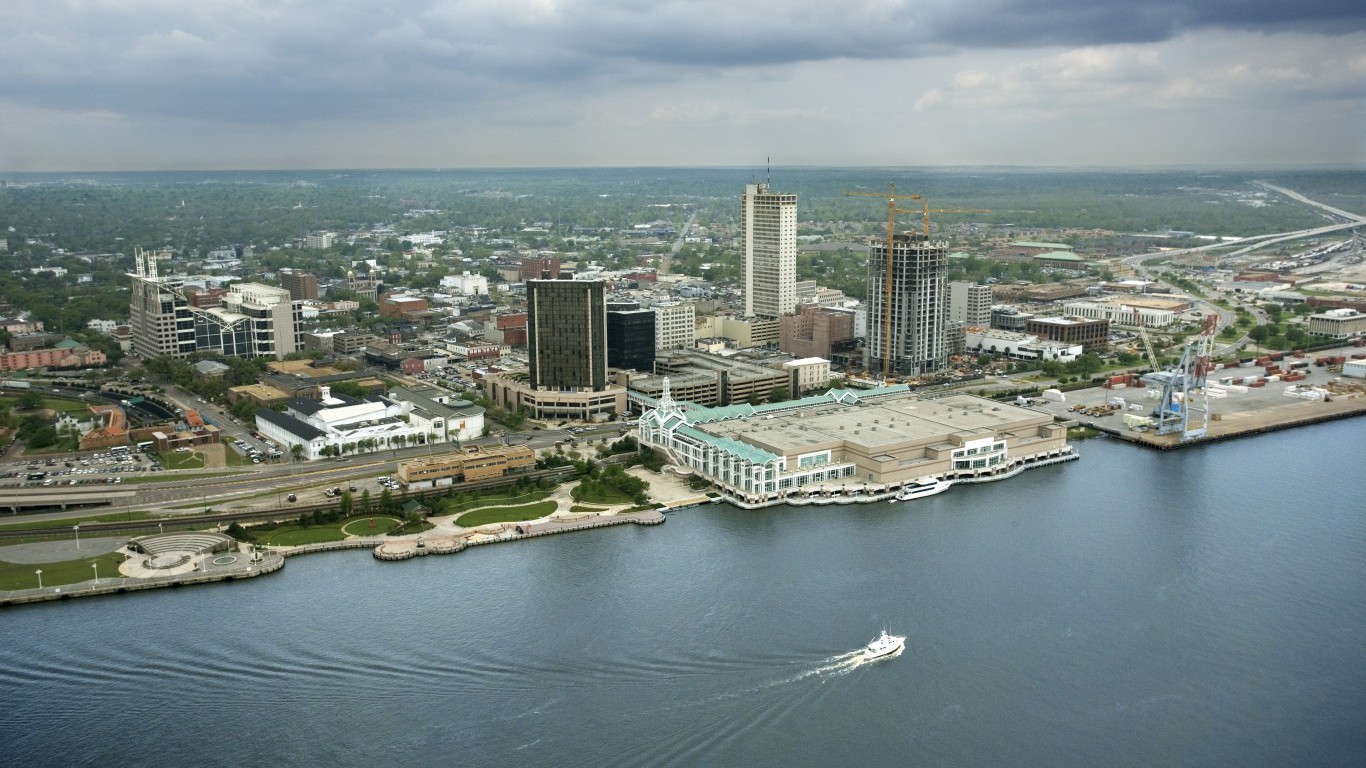
Alabama: Mobile
> Population: 192,895
> Median home value: $125,100
> Poverty rate: 21.4%
> Violent crimes per 100,000 people: 886
Alabama is a relatively poor state. Some 17.1% of the population lives below the poverty line, a larger share than the 14.0% of Americans who do. In Mobile, financial hardship is even more common, as 21.4% of the population lives below the poverty line — and this is exacerbated by a weak job market. Mobile’s 7.1% annual unemployment rate is well above the state rate of 6.0% and the national rate of 4.9%.
As is often the case in the cities on this list, Mobile’s population is shrinking. In the last five years, the number of people living in the city declined by 1.0% — even as the U.S. population grew 3.7% over the same period.
[in-text-ad]
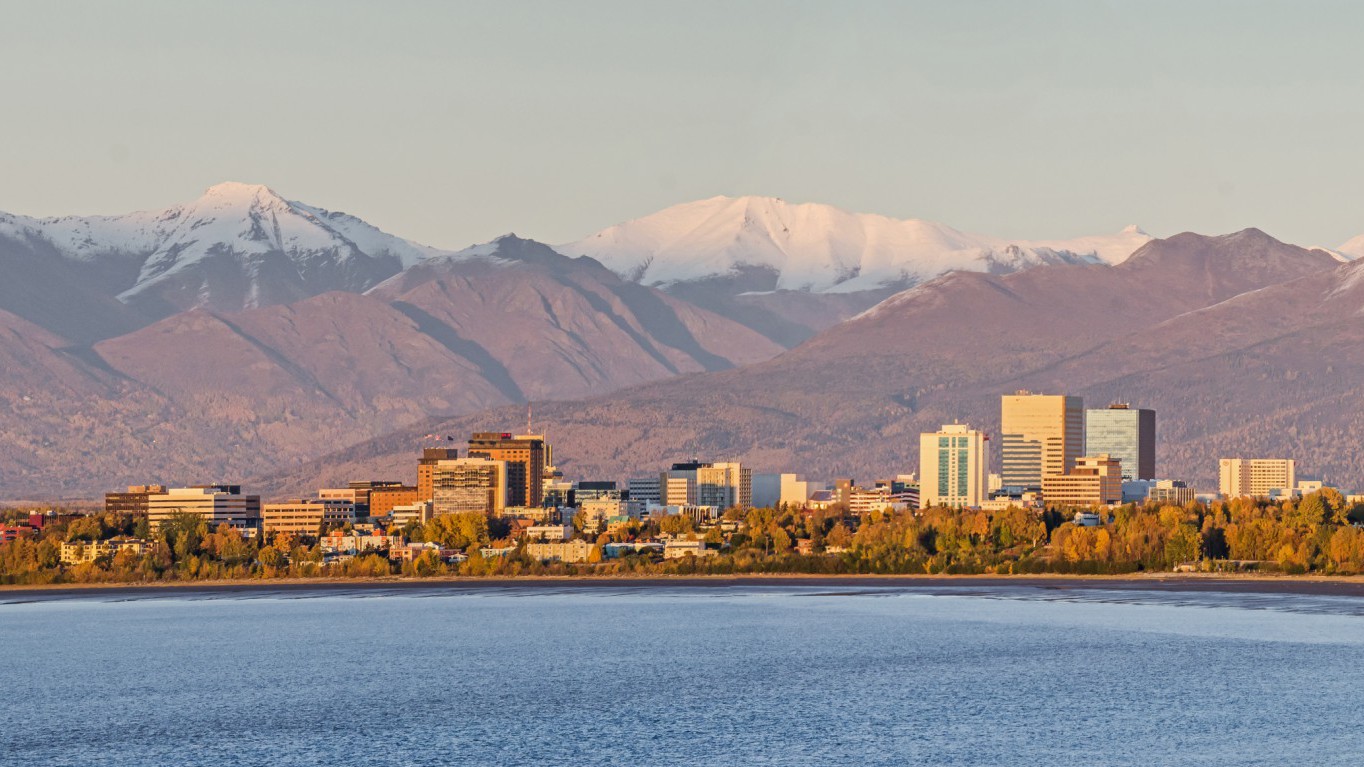
Alaska: Anchorage
> Population: 299,321
> Median home value: $298,000
> Poverty rate: 8.1%
> Violent crimes per 100,000 people: 1,144
Of the three ranked cities in Alaska — Fairbanks, Juneau, and Anchorage — Anchorage is by far the most dangerous. There were 1,144 violent crimes in the city for every 100,000 people in 2016. The second highest violent crime rate in the state is 855 incidents per 100,000 people in Juneau.
Job opportunities have vanished in Anchorage in recent years. Total employment in the city fell by 1.4% from 2014 to 2016, even as employment climbed 3.5% nationwide over the same period. The city’s annual unemployment rate of 5.3% is above the 4.9% national rate but slightly below the 6.6% state rate.
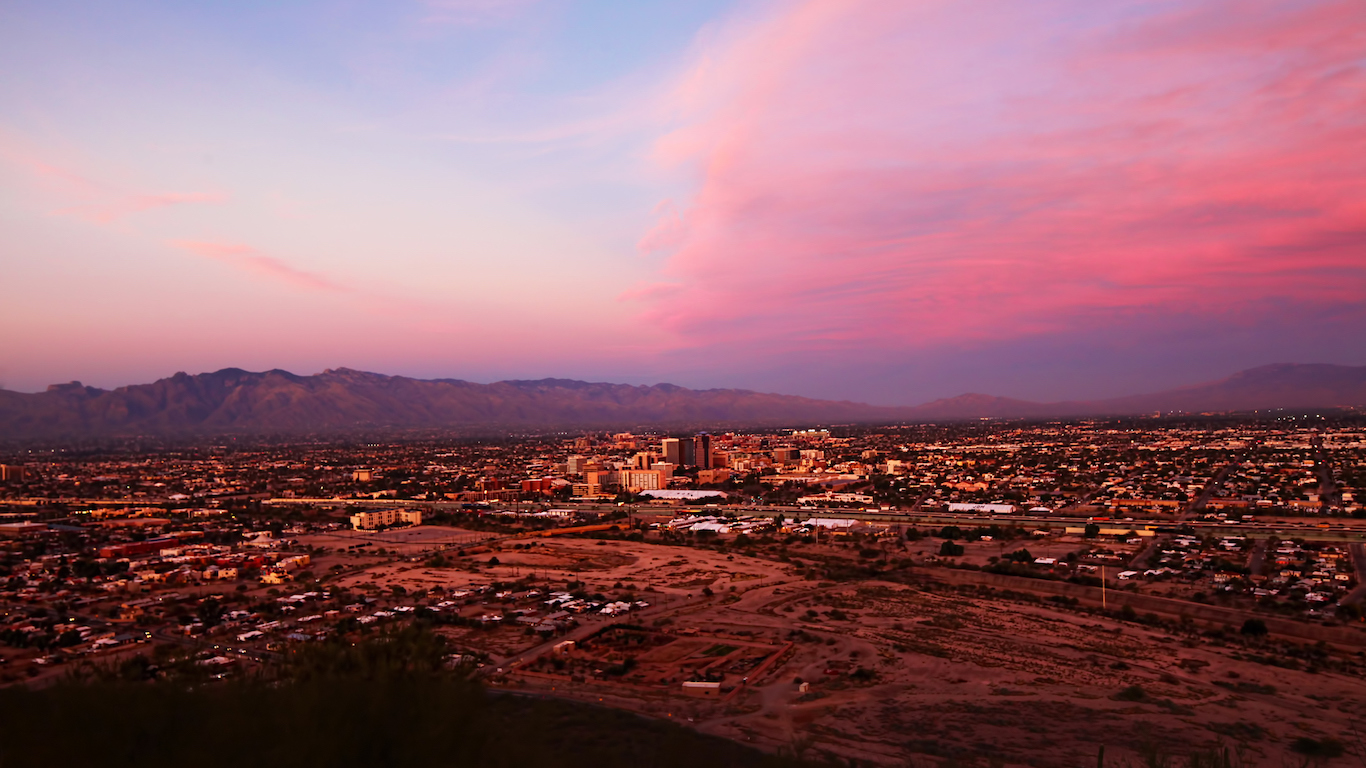
Arizona: Tucson
> Population: 530,690
> Median home value: $144,000
> Poverty rate: 24.1%
> Violent crimes per 100,000 people: 800
The typical household in Tucson, Arizona, earns just $40,021 a year, less than three-quarters the median income of $53,558 across the state as a whole. The impact of low incomes is evident in the high share of area residents living in poverty. Of the over half a million people living in Tucson, 24.1% live below the poverty line, the highest poverty rate of any city in the state.
Not only is Tucson the poorest city in Arizona, but also it is the most dangerous. There were 4,245 violent crimes in the city in 2016, or 800 for every 100,000 people. For comparison, there were 470 violent crimes per 100,000 people statewide in 2016.

Arkansas: Little Rock
> Population: 198,546
> Median home value: $161,000
> Poverty rate: 18.8%
> Violent crimes per 100,000 people: 1,533
Little Rock is the most dangerous city in Arkansas and one of the most dangerous in the United States. There were 1,533 violent crimes for every 100,000 residents in the city in 2016 — compared to 551 per 100,000 statewide and 386 per 100,000 nationwide.
Area residents also face an elevated risk of natural disasters — particularly tornadoes. Many consider Arkansas part of the Tornado Alley, a region of the country where tornadoes occur with greater frequency, and Little Rock is in a part of the state at especially high risk.
[in-text-ad-2]
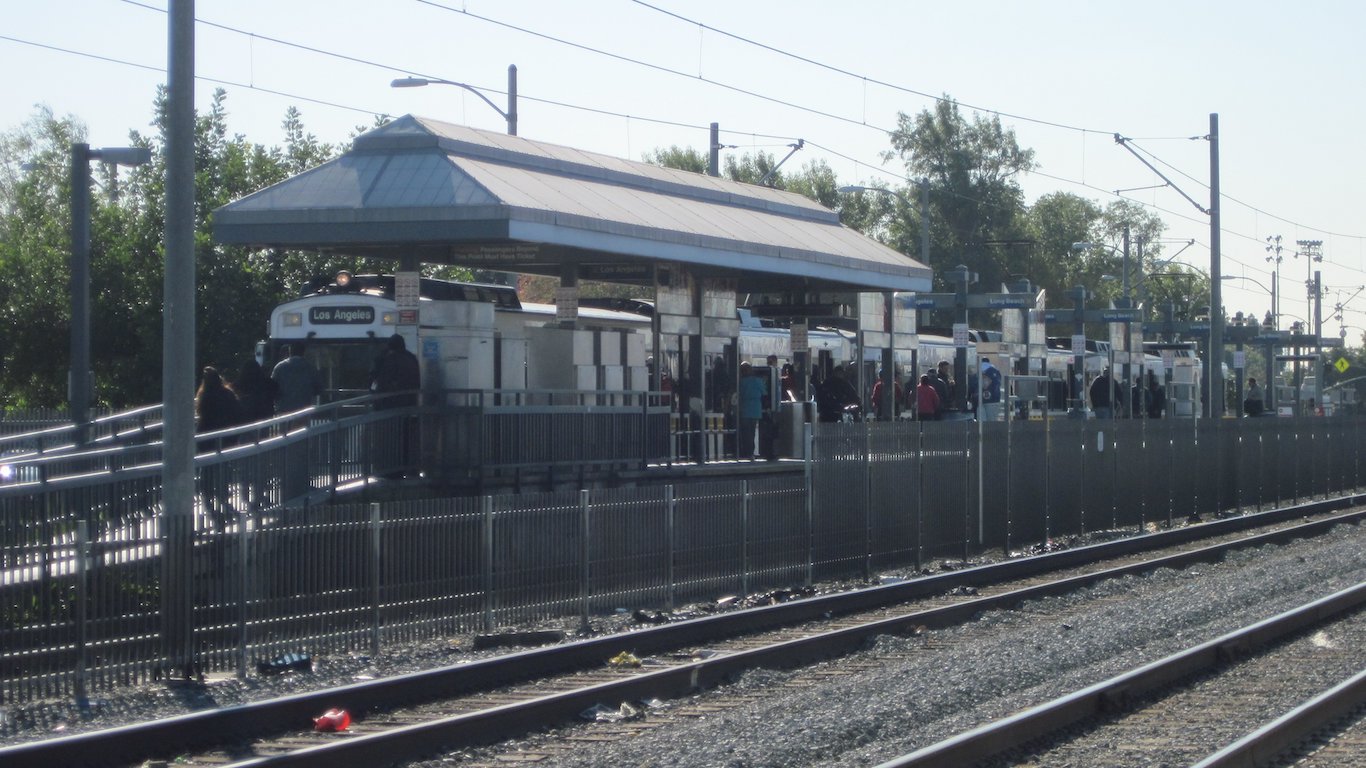
The typical household in Florence-Graham, California, earns $34,738 a year, about half the income the typical California household earns and well-below the $57,617 median income nationwide. Area households face additional financial strain from the high cost of living. Goods and services are 36.8% more expensive in Florence-Graham than they are nationwide on average.
For workers across the country, long commute times can contribute to stress and detract from overall quality of life. In Florence-Graham, the average commute is 32 minutes, nearly 6 minutes longer than the national average. Over the course of a week, a commuter in the city spends about an hour longer than the typical American worker commuting to and from work.

Colorado: Pueblo
> Population: 110,295
> Median home value: $126,200
> Poverty rate: 24.2%
> Violent crimes per 100,000 people: 980
Pueblo is the only city in Colorado where more than one in every five residents live in poverty. The city’s high poverty rate is likely due in part to the weak job market, as Pueblo’s 5.3% annual unemployment rate is well above Colorado’s 3.3% rate. Pueblo is also dangerous. There were 1,081 violent crimes in the city in 2016, or 980 for every 100,000 people, by far the most of any city in the state.
As is often the case in low-income, high-crime cities, real estate values are depressed in Pueblo. The typical home in the city is worth just $126,200, less than half the value of the typical home in Colorado as a whole.
[in-text-ad]

Connecticut: Hartford
> Population: 123,287
> Median home value: $161,200
> Poverty rate: 27.3%
> Violent crimes per 100,000 people: 1,097
Hartford is the poorest city in Connecticut. The typical household in Hartford earns just $36,637 a year, less than half the median income of $73,433 across the state as a whole. The lower-income households in Hartford face additional budgetary strain due to the area’s high cost of living. Goods and services are 17% more expensive in the city than they are on average nationwide. High taxes help explain the area’s high cost of living. Homeowners pay on average 2.3% of their home value in property taxes a year, more than double the 1.1% national average property tax rate.
The high cost of living may be driving some out of the city. In the last half decade, the city’s population contracted by 1.3%, even as the U.S. as a whole grew by 3.7%.

Delaware: Wilmington
> Population: 71,455
> Median home value: $145,600
> Poverty rate: 27.7%
> Violent crimes per 100,000 people: 1,798
Wilmington, Delaware, has the highest violent crime rate in the state and one of the highest in the United States. There were nearly 1,800 violent crimes reported for every 100,000 residents in 2016 — more than triple the state rate. No other Delaware city had even half as many violent crimes reported per 100,000 residents.
Many in Wilmington also struggle with serious financial hardship. Wilmington’s poverty rate of 27.7% is the highest of any Delaware city and more than double the statewide poverty rate of 11.7%.
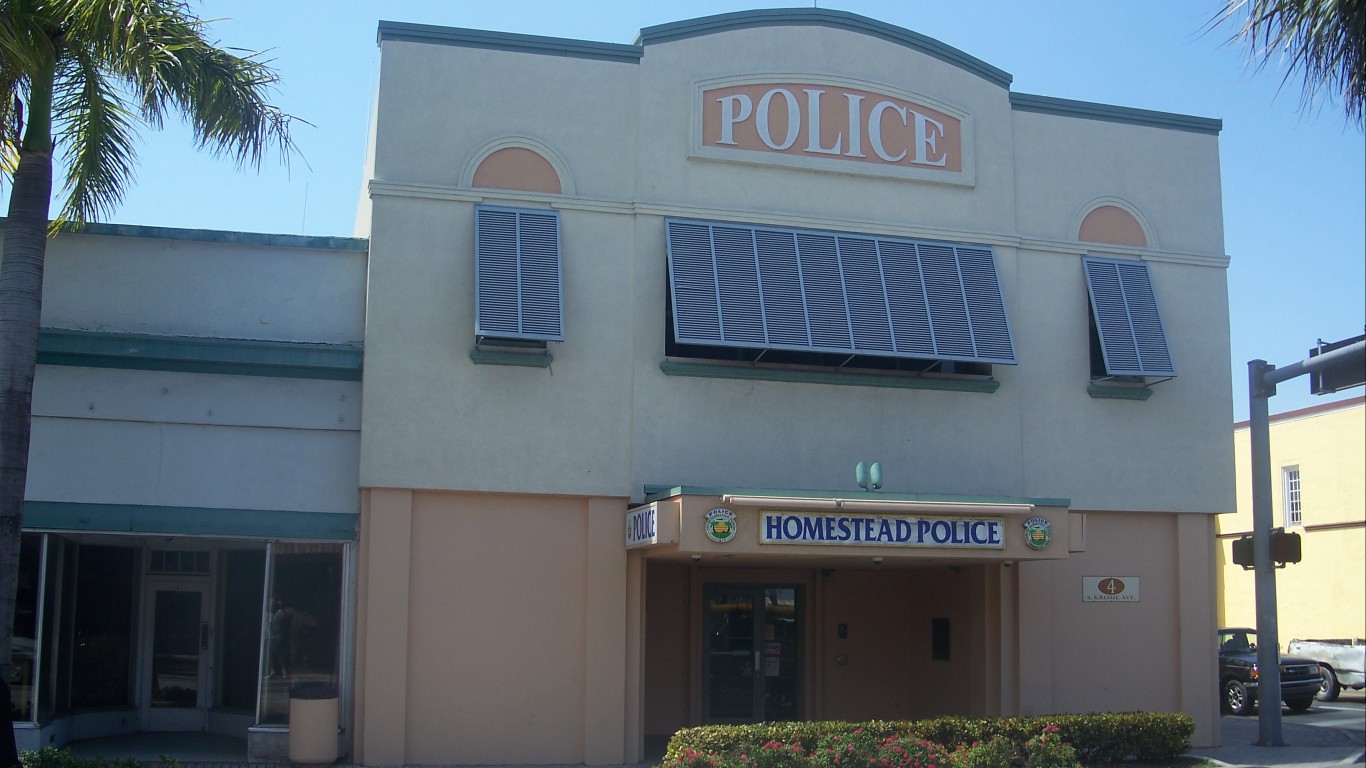
Florida: Homestead
> Population: 68,000
> Median home value: $204,800
> Poverty rate: 33.9%
> Violent crimes per 100,000 people: 1,178
The typical household in Homestead, Florida, earns just $32,001 a year, about $25,600 less than national median household income. The lower than typical incomes likely exacerbate the financial strain caused by the city’s high cost of living. Goods and services are, on average, 15% more expensive in Homestead than they are nationwide.
Homestead residents also face an elevated risk of property damage, injury, and death due to natural disasters. Located just south of Miami, not far from Atlantic Coast, few U.S. cities deal with greater threats from natural disasters such as floods and hurricanes than Miami Beach.
[in-text-ad-2]
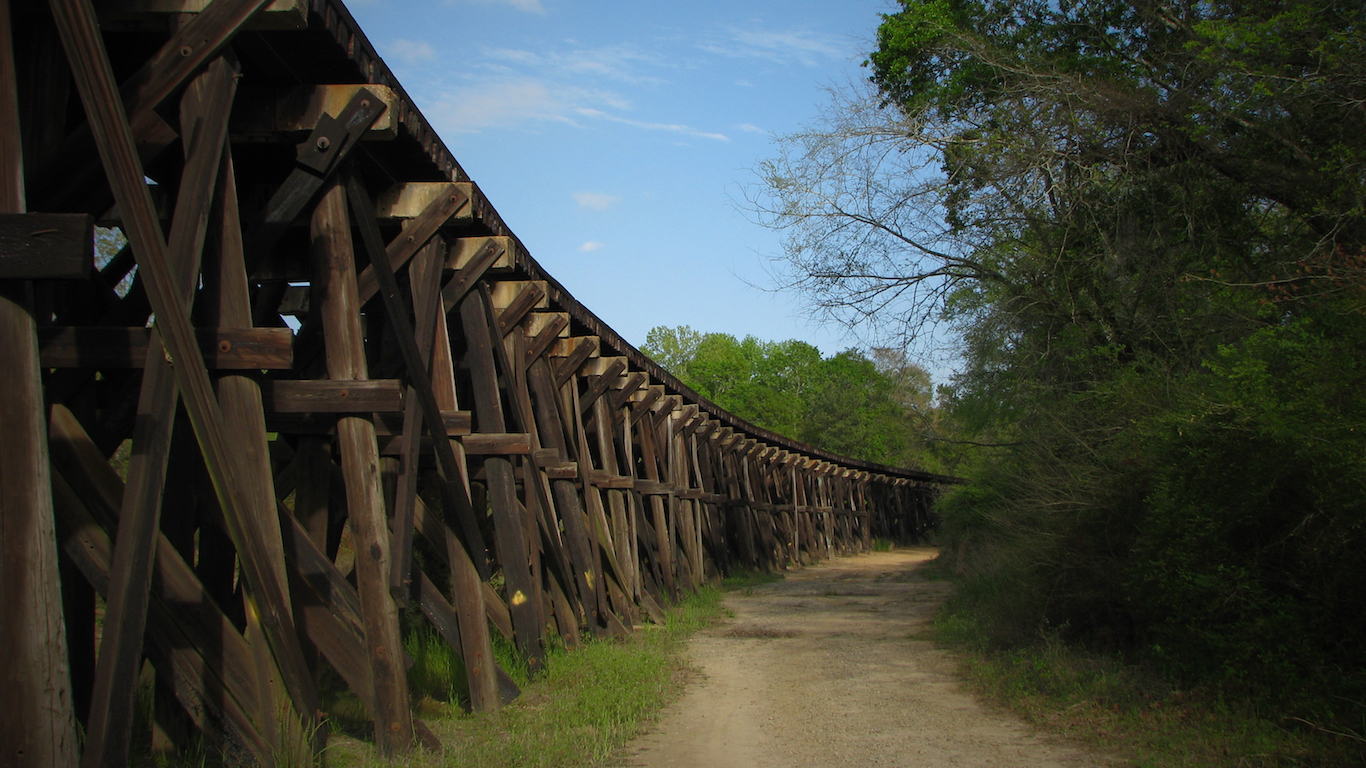
Georgia: Albany
> Population: 74,904
> Median home value: $88,800
> Poverty rate: 32.5%
> Violent crimes per 100,000 people: 1,165
Nearly a third of the population in Albany, Georgia, lives on poverty level income, more than double the state’s 16.0% poverty rate. The low incomes are likely due in part to a weak job market. The city’s 7.0% unemployment rate is the highest in Georgia and well above the 4.9% national unemployment rate. Areas with widespread joblessness also often have a greater than typical concentration of crime, and Albany is no exception. There were 1,165 violent crimes in the city for every 100,000 people in 2016 compared to 398 per 100,000 across Georgia as a whole.
As is often the case among cities on this list, Albany may be struggling to attract new residents — or keep current ones. In the last half decade, the number of people living in the city declined by 4.8%, one of the steepest drops of any city in the country.
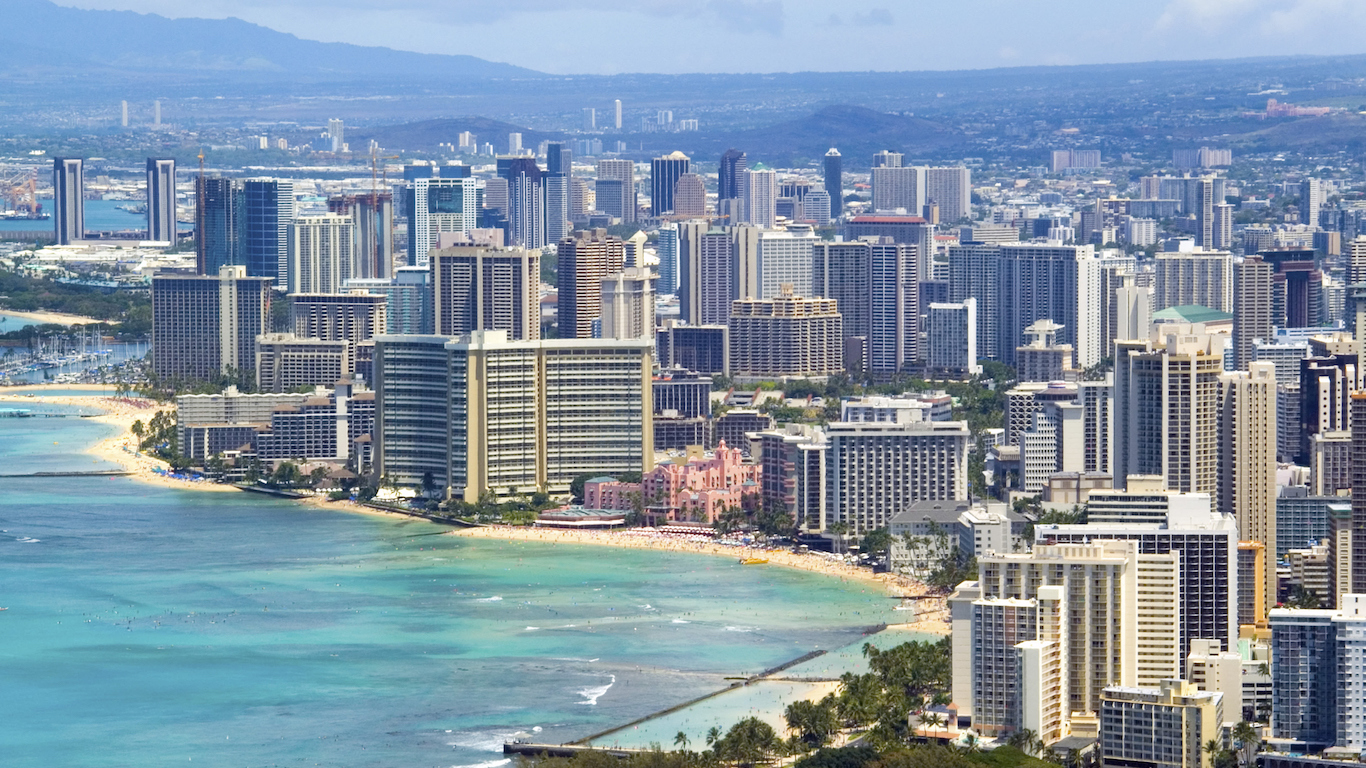
Hawaii: Urban Honolulu
> Population: 349,597
> Median home value: $601,500
> Poverty rate: 12.1%
> Violent crimes per 100,000 people: 335
The median household income in Urban Honolulu of $63,361 a year is nearly $11,200 below the state median of $74,511. Urban Honolulu’s poverty rate of 12.1% is also greater than the state’s poverty rate of 9.3%. Urban Honolulu residents also have to grapple with a high cost of living. Driven largely by housing and utilities costs, goods and services are about 61% more expensive in Urban Honolulu than they are nationwide.
City residents also are more likely than residents of Hawaii as a whole to report violent crimes. There were 335 violent crimes per 100,000 residents in Urban Honolulu in 2016. Hawaii’s violent crime rate is 309 per 100,000.
[in-text-ad]

Idaho: Nampa
> Population: 91,375
> Median home value: $142,900
> Poverty rate: 15.7%
> Violent crimes per 100,000 people: 363
Nampa lags behind Idaho as a whole in a number in a number of key economic measures. The state’s unemployment rate is 3.8%; Nampa’s is 4.4% — making it the only large city in Idaho with a higher unemployment rate than the state as a whole. Similarly, the state median household income is $51,807; Nampa’s is $44,079 — also the only large city with a lower median household income than the state’s.
The Nampa violent crime rate is significantly higher than that of Idaho as a whole. There were more than 363 violent crimes reported for every 100,000 Nampa residents in 2016. In Idaho, the violent crime rate is much lower at 230 violent crimes per 100,000 residents.

Illinois: Rockford
> Population: 147,404
> Median home value: $89,200
> Poverty rate: 22.6%
> Violent crimes per 100,000 people: 1,658
Rockford’s economy is struggling, as evidenced by the weak job market. From 2014 through 2016, the number of people employed in the city climbed by just 1.1%, less than a third of the comparable national employment growth. The city’s most recent annual unemployment rate of 7.7% is also the highest in the state and well above the 4.9% national rate. A high crime rate can have a depressing effect on commerce, and Rockford is a particularly dangerous city. There were 1,658 violent crimes for every 100,000 people in the city in 2016, nearly the highest violent crime rate of any U.S. city and more than triple the violent crime rate of 436 per 100,000 across Illinois as a whole.
The city’s high crime levels and weak job market may be driving people away. In the last five years, the number of people living in Rockford dropped by 3.3%, even as the U.S. population expanded by 3.7%.

Indiana: Gary
> Population: 74,186
> Median home value: $64,800
> Poverty rate: 33.3%
> Violent crimes per 100,000 people: 620
Few U.S. cities are shrinking faster than Gary, Indiana. In the last decade, the city’s population fell by 8.0%, while the population of nearly every other city in the state either grew or remained effectively unchanged. For reference, the U.S. population expanded by 7.1% over the same period. A lack of job opportunities in the city likely partially explains the population decline. Gary’s 9.0% unemployment rate in 2016 is among the worst in the nation and more than double the 4.4% statewide rate.
Gary residents have relatively little in the way of dining and entertainment options. There are just 78 restaurants, cafes, and other similar dining venues for every 100,000 city residents, nearly the lowest concentration of any U.S. city and less than half the national concentration of 168 per 100,000.
[in-text-ad-2]
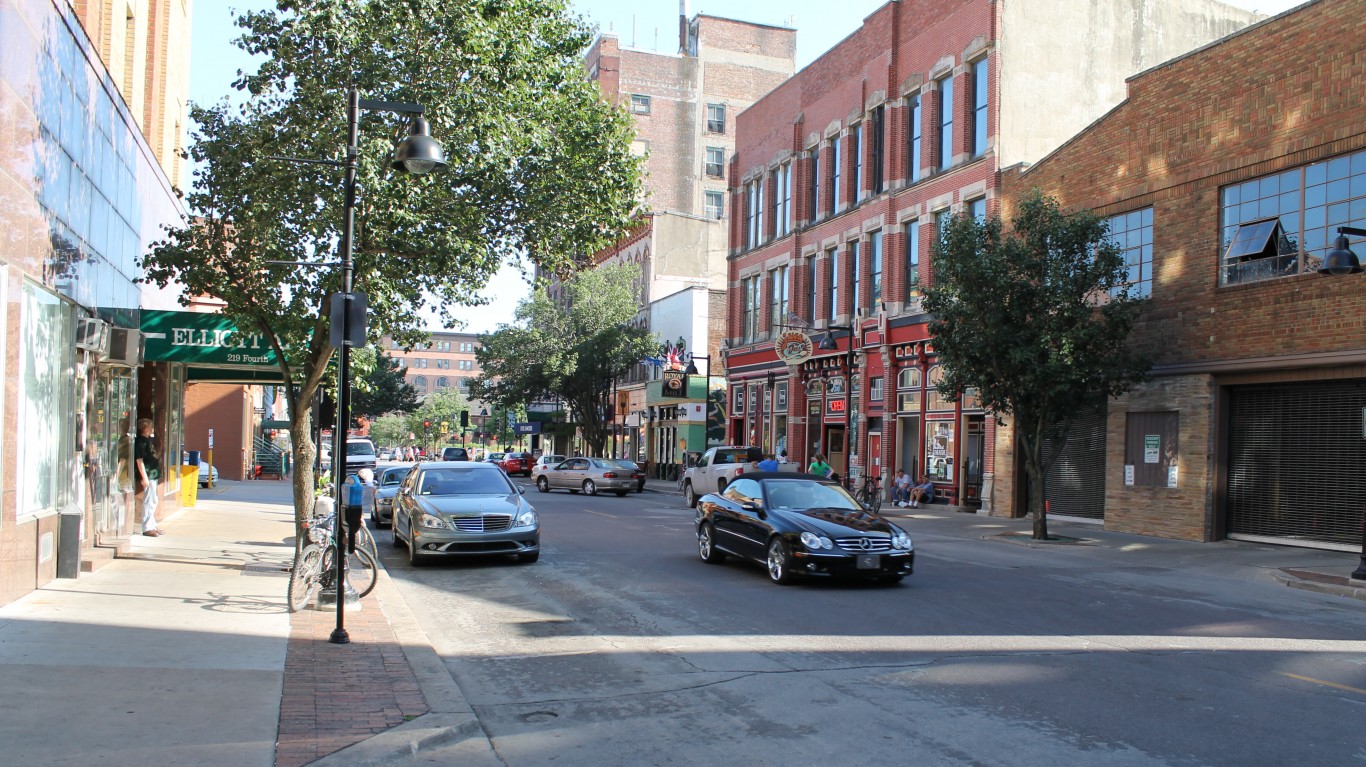
Iowa: Des Moines
> Population: 215,328
> Median home value: $126,100
> Poverty rate: 16.2%
> Violent crimes per 100,000 people: 695
Job growth has been stagnant in Des Moines in recent years. Total employment in the city grew by just 0.4% from 2014 to 2016, even as employment climbed 3.5% nationwide over the same period. The city’s annual unemployment rate of 4.1% is above the 3.7% state rate. The city’s relatively weak job market partially explains financial hardship in the area. Some 16.2% of residents live on poverty level incomes, well above the poverty rates of 11.8% statewide and 14.0% nationwide.
Des Moines has more crime than most other cities in Iowa. There were 695 violent crimes for every 100,000 people in Des Moines in 2016, well more than double the statewide violent crime rate of 291 per 100,000.

Kansas: Wichita
> Population: 389,927
> Median home value: $123,500
> Poverty rate: 17.8%
> Violent crimes per 100,000 people: 1,061
The nation as a whole has added jobs continuously every month for nearly eight years. Wichita, Kansas, is one of the rare U.S. cities to buck the national trend. In the last two years, total employment dropped by 0.2% in Wichita, even as employment climbed by 3.5% nationwide over the same period.
A high crime rate may be stifling commerce in Wichita. There were 1,061 violent crimes for every 100,000 people in the city in 2016, well more than double the statewide violent crime rate of 380 per 100,000.
[in-text-ad]

Kentucky: Louisville/Jefferson County
> Population: 616,261
> Median home value: $150,900
> Poverty rate: 15.7%
> Violent crimes per 100,000 people: 750
Louisville/Jefferson County is by far the most dangerous city in Kentucky. There were 750 violent crimes for every 100,000 area residents in 2016, more than double the violent crime rate in both Bowling Green and Lexington-Fayette, the two other cities in the state, and more than triple the 232 per 100,000 violent crime rate across Kentucky as a whole.
Unemployment is also relatively high in Louisville/Jefferson County. The city’s annual jobless rate of 4.4% — while lower then the 4.9% national rate — is higher than that of both other large cities in the state.

Louisiana: Shreveport
> Population: 194,472
> Median home value: $150,000
> Poverty rate: 30.8%
> Violent crimes per 100,000 people: 959
Shreveport has the weakest job market of any large city in Louisiana. The annual unemployment rate of 6.6% in Shreveport is higher than the comparable state rate of 6.1% and the national rate of 4.9%. As is the case in several other Louisiana cities, jobs are disappearing in Shreveport. Overall employment fell by 2.4% in the city from 2014 to 2016, even as total employment climbed 3.5% nationwide over the same period.
The weak job market may partially explain low incomes in the city. The typical area household earns $34,647 a year — only about three-quarters of the median income of $45,146 across the state as a whole.

Maine: Bangor
> Population: 32,491
> Median home value: $148,600
> Poverty rate: 25.1%
> Violent crimes per 100,000 people: 232
Bangor, Maine, has one of the highest incidences of property crime in the country. There were 4,153 property crimes reported for every 100,000 residents in Bangor in 2016, well above the national rate of 2,451 per 100,000. Bangor’s 4.8% unemployment rate is also the highest of any major city in the state.
Though not always the case, crime is often more prevalent in economically struggling areas. Bangor has the lowest median household income of any city in the state at $37,987 a year — well below the $50,826 state median.
[in-text-ad-2]

Maryland: Baltimore
> Population: 614,664
> Median home value: $153,500
> Poverty rate: 21.9%
> Violent crimes per 100,000 people: 1,791
Baltimore, by far the largest city in Maryland, is struggling by a number of key socioeconomic indicators. More than one in every five city residents live below the poverty line, over double the state poverty rate of 9.7%. The city is also dangerous. There were 1,791 violent crimes for every 100,000 city residents in 2016, one of the highest violent crime rates of any U.S. city and nearly quadruple the statewide violent crime rate.
As is the case with several cities on this list, people are leaving Baltimore faster than they are coming in. The city’s population declined by 3.6% in the last decade. The total U.S. population climbed by 7.1% over the same period.

Massachusetts: Springfield
> Population: 154,079
> Median home value: $154,300
> Poverty rate: 24.7%
> Violent crimes per 100,000 people: 1,031
According to a number of socioeconomic factors, Springfield ranks as the worst city to live in Massachusetts. The typical household in Springfield earns $38,897 a year, the second least of any city in Massachusetts and less than the national median of $57,617. Additionally, 24.7% of Springfield residents live in poverty, the highest poverty rate of cities in the state.
Though not always the case, crime is often more prevalent in low income areas. In 2016, there were 1,031 violent crimes reported per 100,000 residents in Springfield, nearly three times the national rate of 386 incidents per 100,000 Americans and the third most of any city statewide.
[in-text-ad]
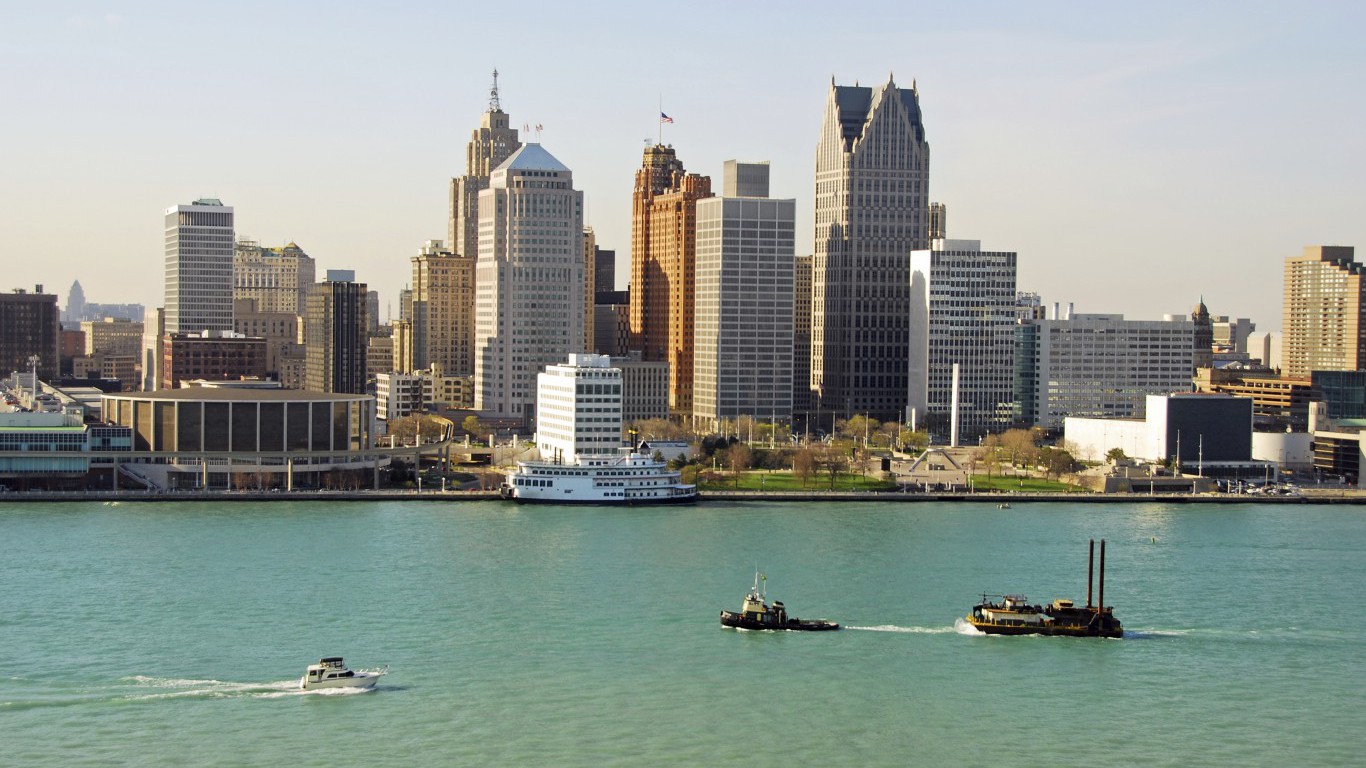
Michigan: Detroit
> Population: 672,829
> Median home value: $43,500
> Poverty rate: 35.7%
> Violent crimes per 100,000 people: 2,037
Detroit is emblematic of the economic and population decline that has befallen much of the Rust Belt. The decline of the automobile industry and population contraction in the mid-20th century gave way to a rise in poverty and violent crime. Today, the typical Detroit household earns just $28,099 a year, the second lowest median household income of cities in Michigan and the sixth lowest of U.S. cities. In 2016, there were 2,037 violent crimes reported per 100,000 residents in Detroit, more than five times the national violent crime rate.
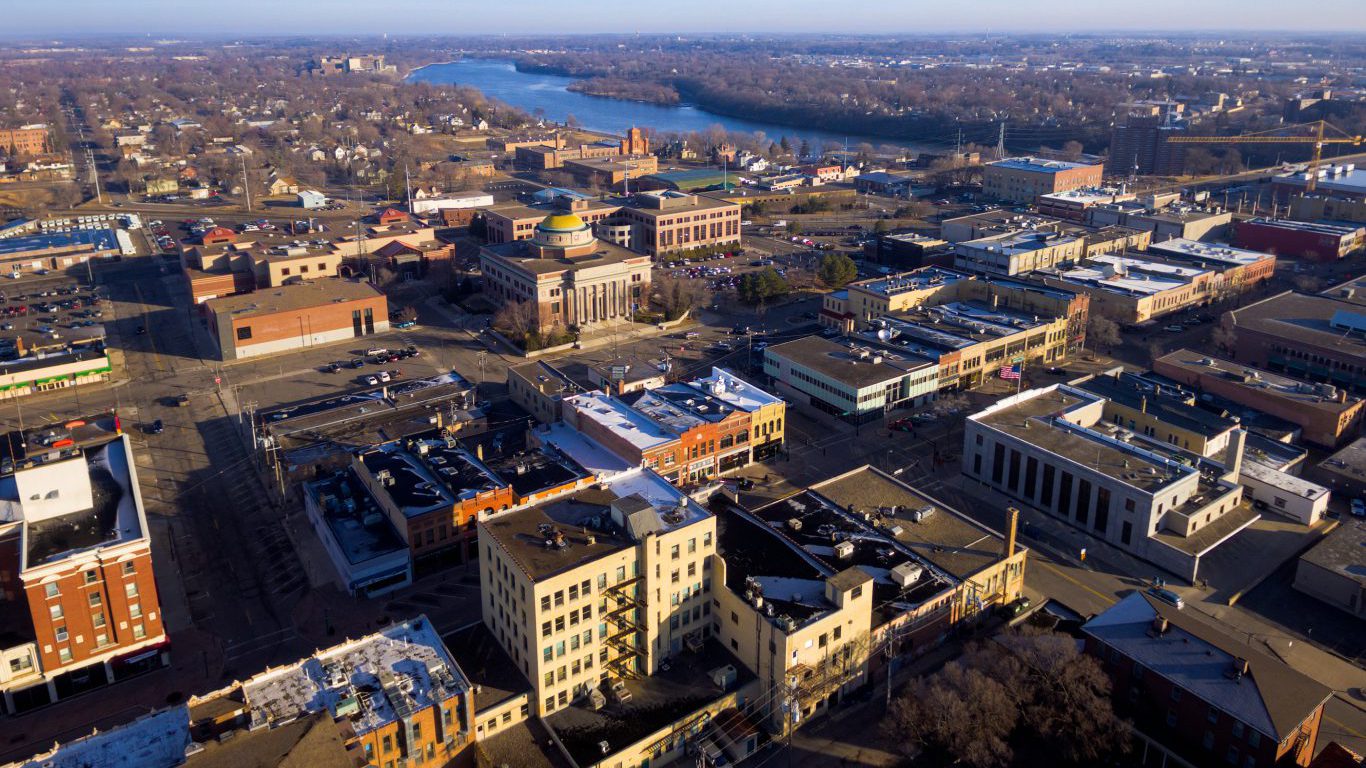
Minnesota: St. Cloud
> Population: 67,396
> Median home value: $155,700
> Poverty rate: 21.6%
> Violent crimes per 100,000 people: 435
Of the 11 Minnesota cities considered, St. Cloud has the highest poverty rate. More than one in five St. Cloud residents live below the poverty line, over double the state’s 9.9% poverty rate. The city also has the state’s highest annual unemployment rate, which at 4.1% is higher than the statewide rate of 3.9% but below the 4.9% national rate. St. Cloud is also the only city in Minnesota to be losing residents faster than it is attracting them. In the last five years, the city’s population contracted by 1.0%.
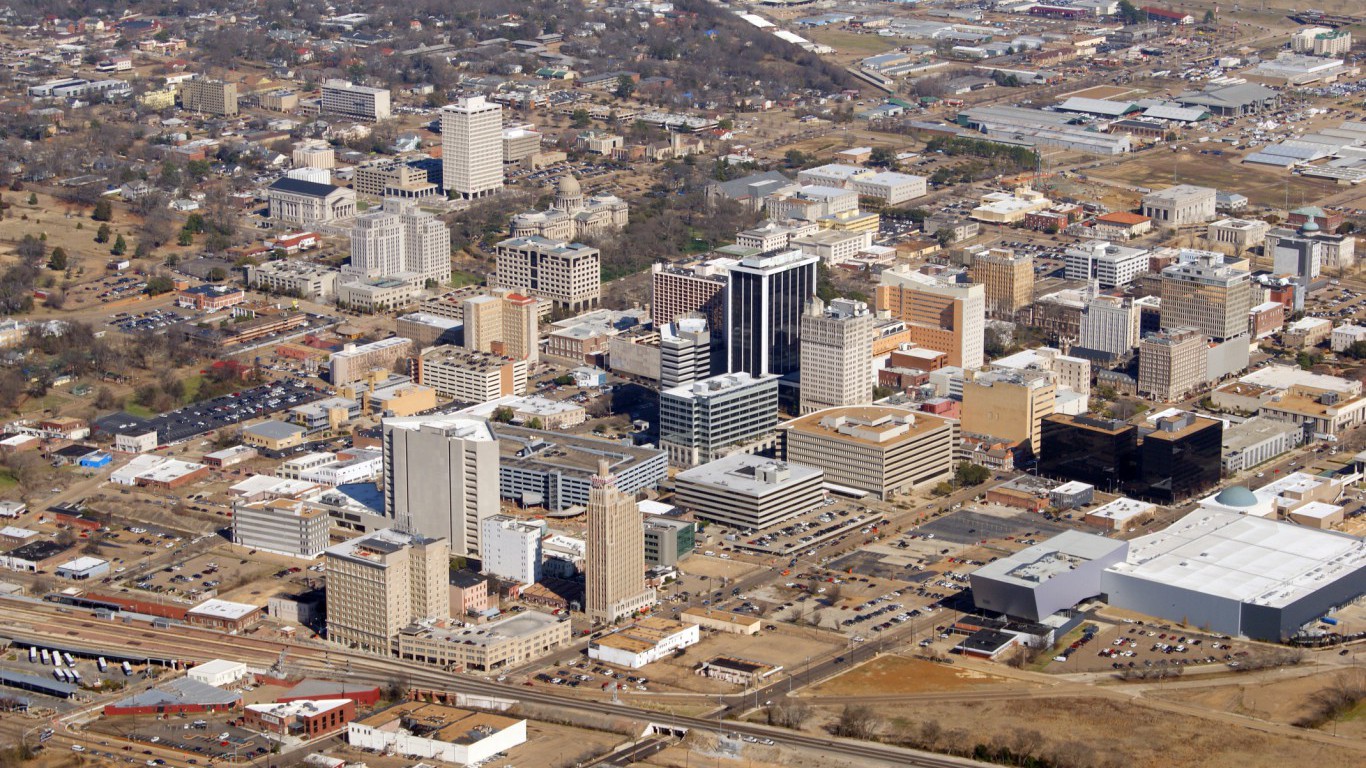
Mississippi: Jackson
> Population: 169,141
> Median home value: $88,500
> Poverty rate: 22.0%
> Violent crimes per 100,000 people: 858
The population of Jackson has declined in recent decades, from a high of 203,000 in 1980 to 169,141 today. According to several members of the Jackson City Council, one of the push factors may have been the city’s poor public school system.
The city is also relatively dangerous. In 2016, there were 858 violent crimes reported per 100,000 residents in Jackson, more than three times the statewide rate of 281 incidents per 100,000 people and more than twice the national rate of 386 incidents per 100,000 Americans.
[in-text-ad-2]

Missouri: St. Louis
> Population: 311,404
> Median home value: $125,800
> Poverty rate: 23.8%
> Violent crimes per 100,000 people: 1,932
According to our index, St. Louis is the worst city to live in Missouri — and one of the worst in the entire country. The median household income of $40,346 a year is $11,400 lower than the state median and $17,300 below the national median. St. Louis also has a poverty rate of 23.8% — well above the state and national poverty rates, which both sit at 14.0%.
St. Louis also struggles with high crime rates. There were 1,932 violent crimes reported for every 100,000 city residents in 2016. For context, Missouri’s violent crime rate of 519 per 100,000 is also among the highest of all states.

Montana: Great Falls
> Population: 59,479
> Median home value: $163,700
> Poverty rate: 16.1%
> Violent crimes per 100,000 people: 271
Great Falls has the lowest median household income of any large city in Montana at $43,497 a year. Similarly, 16.1% of the population live in poverty, slightly above the 14.0% U.S. poverty rate.
Aside from lower than typical incomes, Great Falls compares favorably to the rest of the country in a number of measures. For example, just 3.0% of the area workforce are unemployed, well below the 4.9% national rate. Great Falls also has a violent crime rate of 271 incidents per 100,000 people, well below the 386 per 100,000 national rate.
[in-text-ad]

Nebraska: Omaha
> Population: 446,956
> Median home value: $149,900
> Poverty rate: 14.4%
> Violent crimes per 100,000 people: 566
Omaha is one of the few cities in the country where jobs are disappearing. Overall employment fell by 1% in the city between 2014 and 2016. Over the same period, overall employment climbed 3.5% nationwide. The city’s unemployment rate stands at 3.3%, slightly higher than the 3.2% state rate.
Omaha is also relatively dangerous. The city’s violent crime rate of 566 incidents per 100,000 residents is far greater than the state rate of 291 violent crimes per 100,000 residents. Omaha also has Nebraska’s highest property crime rate.
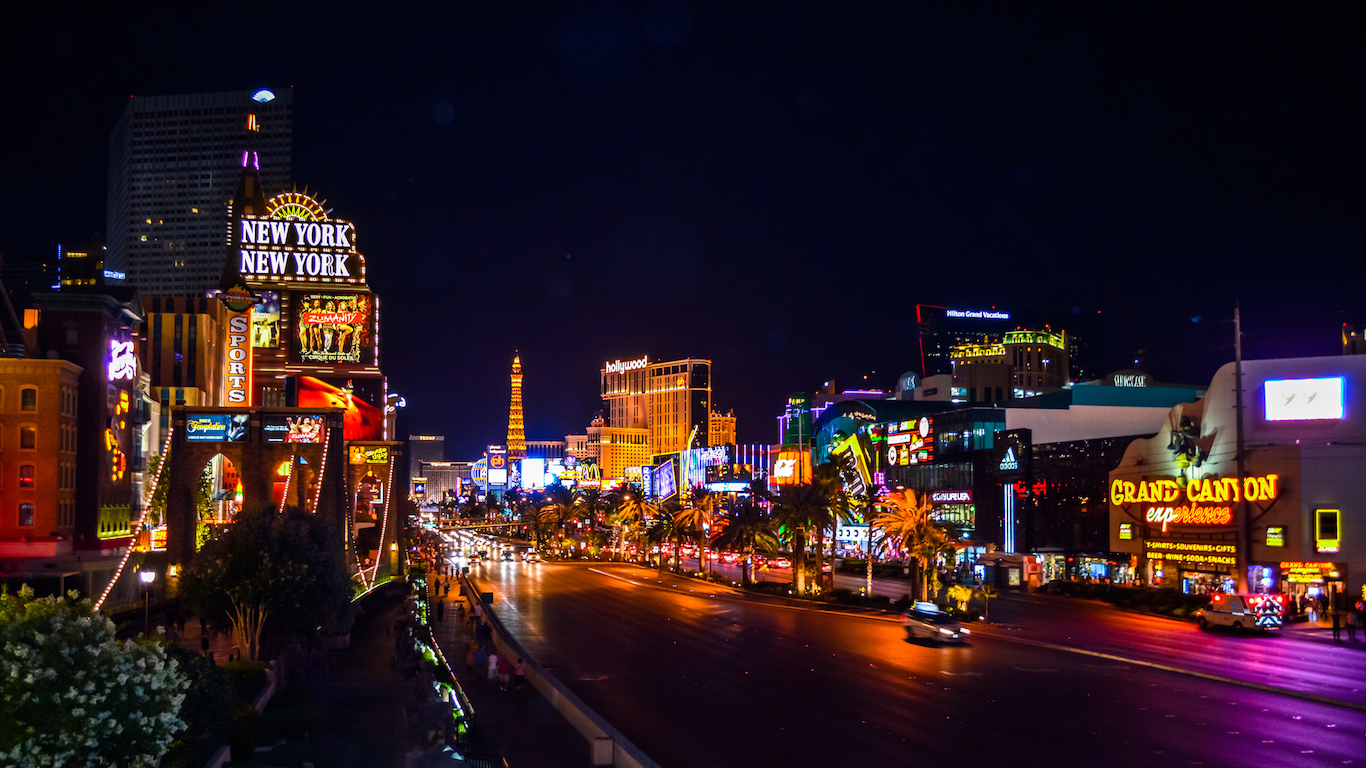
Nevada: Las Vegas
> Population: 632,916
> Median home value: $228,300
> Poverty rate: 15.6%
> Violent crimes per 100,000 people: 849
Despite the high-roller image Las Vegas projects to tourists, the city’s actual residents are not particularly wealthy. The median household income in the city of $51,115 a year is several thousand dollars below the state median of $55,180. Low incomes may be attributable in part to the scarcity of job opportunities. Some 6.0% of the city’s labor force are unemployed, higher than both 5.7% state and the 4.9% national unemployment rates.
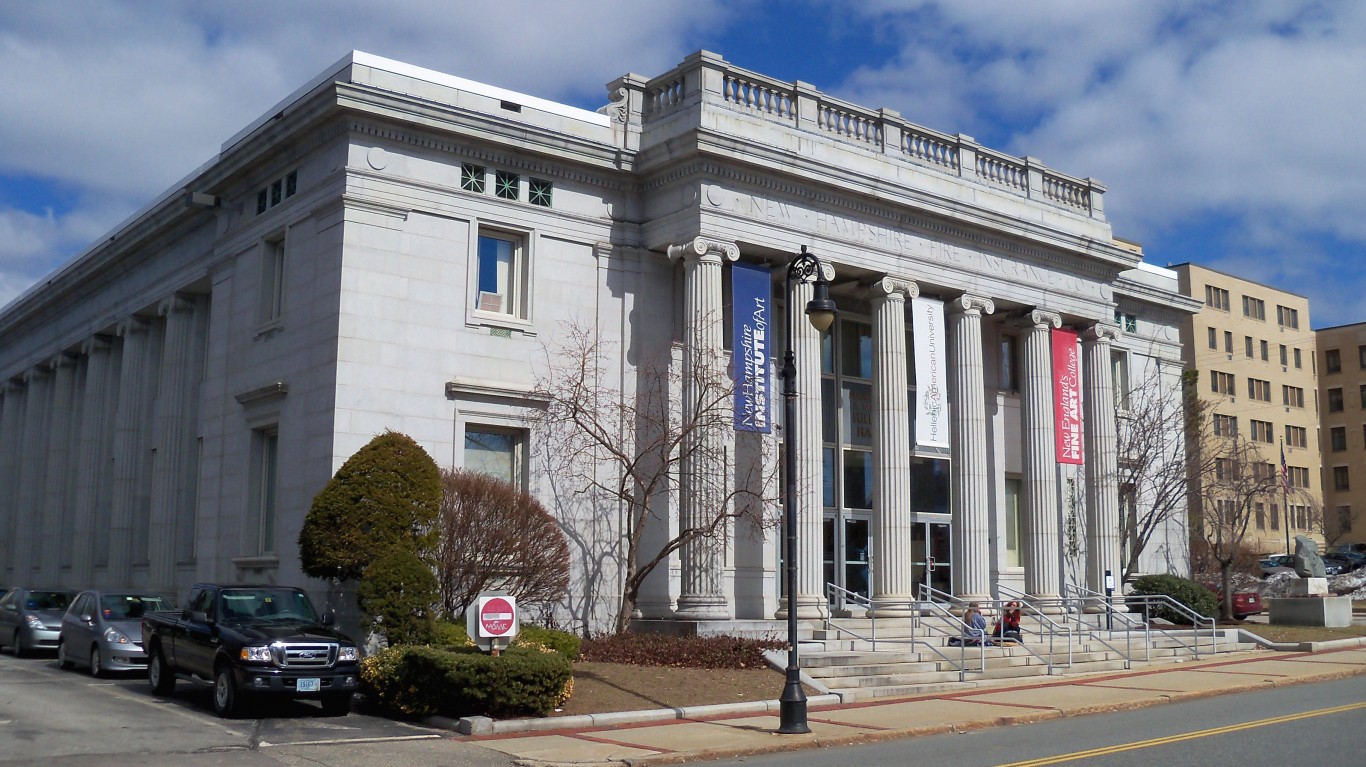
New Hampshire: Manchester
> Population: 110,499
> Median home value: $219,300
> Poverty rate: 14.1%
> Violent crimes per 100,000 people: 672
Steady population growth can be indicative of a vibrant, economically healthy city. In Manchester, New Hampshire, population growth has been stagnant. In the past five years, the population of the city increased by just 0.6%, the lowest of any large city in the state. For reference, the population grew by 3.7% over the last five years nationwide.
Incomes in the city are also relatively low, especially after accounting for the area’s high cost of living. The city’s median household income of $54,664 a year is well below New Hampshire’s median of $70,936 and the $57,617 national median. Additionally, goods and services are about 14% more expensive in Manchester than they are nationwide on average.
[in-text-ad-2]

New Jersey: Trenton
> Population: 84,065
> Median home value: $86,500
> Poverty rate: 27.8%
> Violent crimes per 100,000 people: 1,341
Trenton, New Jersey, faces more severe economic challenges than almost any other U.S. city. The city’s median household income of $31,592 a year is nearly $45,000 below the state median.
As is the case in many cities on this list, people are leaving Trenton faster than they are coming. Over the past five years, Trenton’s population shrank by 1.0%, even as the total U.S. population grew by 3.7% over the same period. A lack of employment opportunities may partially explain the population decline. Trenton’s annual unemployment rate of 7.2% is well above the state unemployment rate of 5.0% and the national rate of 4.9%.

New Mexico: Albuquerque
> Population: 559,270
> Median home value: $191,600
> Poverty rate: 17.1%
> Violent crimes per 100,000 people: 1,117
Albuquerque ranks as the worst place in New Mexico to live largely because of its crime rate. There were 1,117 violent crimes reported for every 100,000 Albuquerque residents in 2016 — nearly three times the rate in Santa Fe, the city with the second highest violent crime rate in New Mexico. Albuquerque also ranks among the top 10 U.S. cities in property crimes, with 6,889 incidents reported for every 100,000 residents in 2016.
Albuquerque’s population growth has been relatively stagnant as of late. Over the past five years, the city’s population grew just 1.2%, the lowest of any large city in New Mexico, and about a third of national population growth rate in that time.
[in-text-ad]

New York: Buffalo
> Population: 256,908
> Median home value: $83,500
> Poverty rate: 30.5%
> Violent crimes per 100,000 people: 1,112
The population of Buffalo, New York, is shrinking. Over the past five years, the city’s population declined by 1.6%. Job growth is also relatively stagnant in the city. Total employment grew by just 0.1% from 2014 through 2016. For reference, the United States as a whole recorded 3.5% total employment growth over the same period.
Low incomes and widespread financial hardship are further evidence of poor economic conditions in the city. Some 30.5% of Buffalo residents live in poverty, well above the state’s 14.7% poverty rate. Buffalo’s median annual household income of $32,883 is also far below New York’s median income of $62,909.

North Carolina: Wilmington
> Population: 117,545
> Median home value: $236,300
> Poverty rate: 24.7%
> Violent crimes per 100,000 people: 646
In North Carolina, 15.4% of residents live below the poverty line. In Wilmington, 24.7% of residents live in poverty — one of the highest poverty rates of any city in the state. Wilmington is also one of only three large cities in North Carolina where over half of all households earn less than $40,000. For reference, the typical household in the state earns $50,584.
Low income areas often struggle with other societal issues, including higher crime rates. Wilmington’s violent crime rate of 646 incidents per 100,000 residents is much higher than the statewide rate of 372 incidents per 100,000 residents.
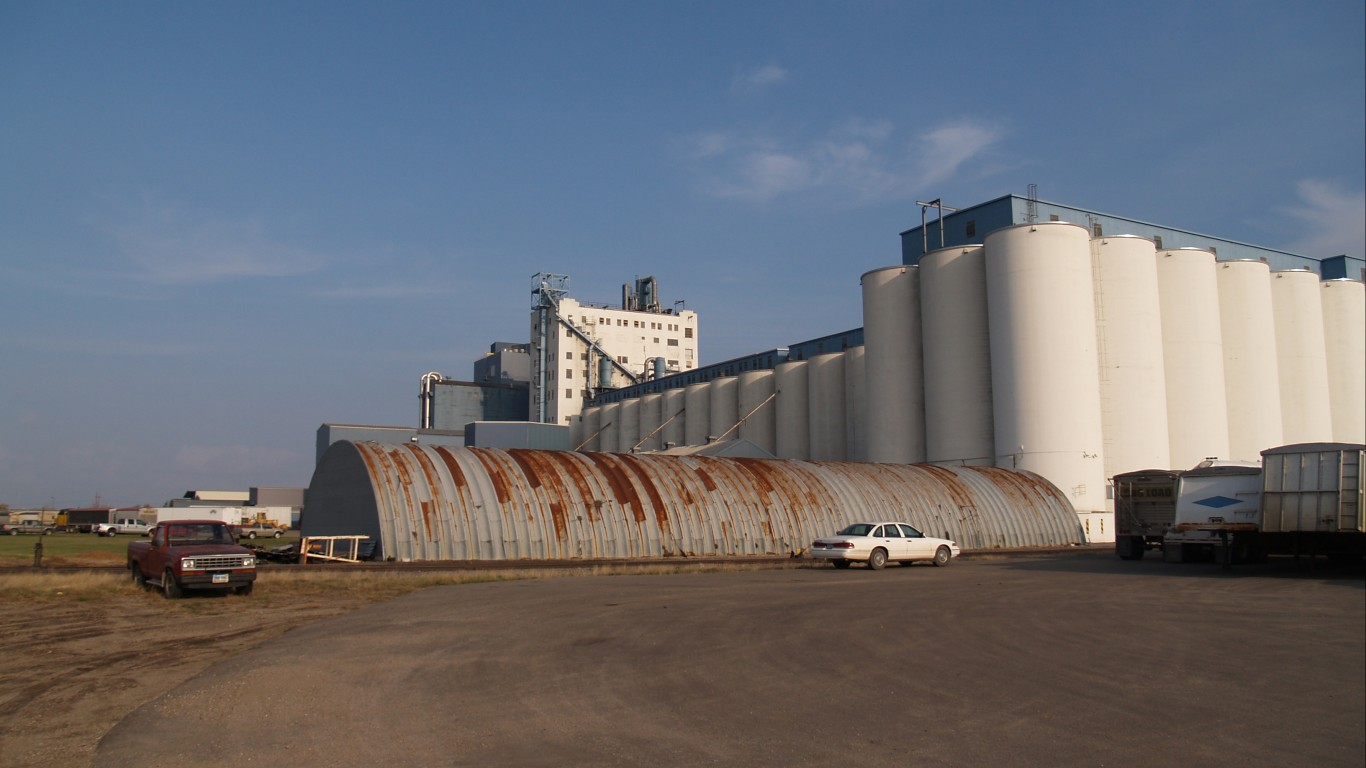
North Dakota: Grand Forks
> Population: 55,831
> Median home value: $172,700
> Poverty rate: 20.6%
> Violent crimes per 100,000 people: .
Grand Forks, along with Bismarck and Fargo, are the three cities in North Dakota large enough to be considered for this list. None rank among the worst places when compared to all U.S. cities, but Grand Forks falls behind the other two cities in a number of key categories and is therefore the worst place to live in North Dakota.
Grand Forks is the only city in the state where more than one in five residents live in poverty. Additionally, at 2.7%, the unemployment rate is higher in Grand Forks than any other city in the state — even though it is slightly below North Dakota’s 3.2% unemployment rate.
[in-text-ad-2]
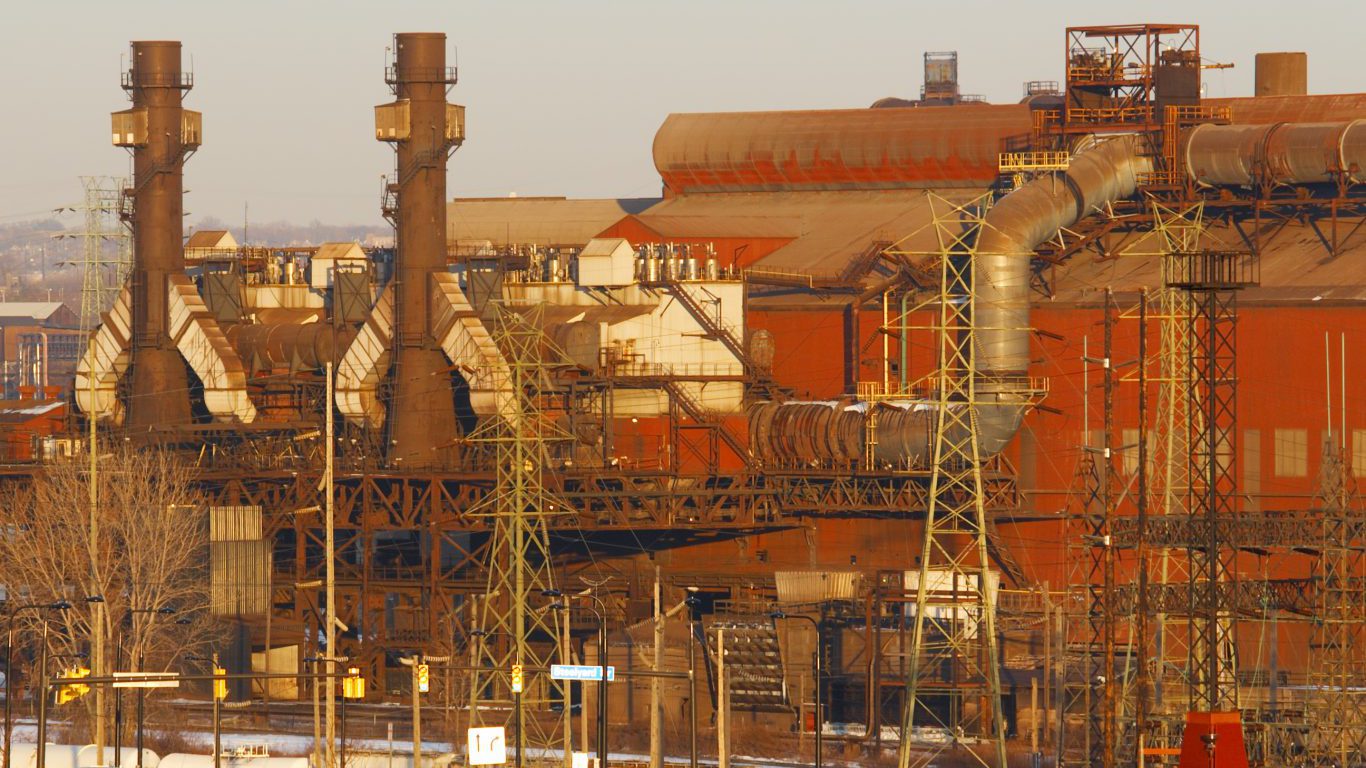
Ohio: Cleveland
> Population: 385,810
> Median home value: $66,800
> Poverty rate: 35.0%
> Violent crimes per 100,000 people: 1,633
Cleveland is one of the poorest cities in both Ohio and the United States. The city’s median household income of just $27,551 a year is about $25,000 less than the state median and $30,000 less than the national median. Unsurprisingly, Cleveland also has one of the nation’s highest poverty rates at 35.0% — more than double the 14.0% national and 14.6% state poverty rates.
The widespread financial hardship in Cleveland is partially attributable to a weak job market. Total employment declined by 0.1% in the city from 2014 to 2016, and the annual unemployment rate stands at 6.9%. Most other Ohio cities added jobs over the same period, and annual unemployment stands at 4.9% across the state as a whole.

Oklahoma: Tulsa
> Population: 403,622
> Median home value: $130,100
> Poverty rate: 20.5%
> Violent crimes per 100,000 people: 1,101
Oklahoma has one of the lowest median household incomes in the country at $49,176 a year. Yet Tulsa’s median is even lower, at $43,134 a year. Tulsa is also the only large city in Oklahoma where more than one in five residents live below the poverty line.
Lower-income areas often have high violent crime rates, and Tulsa is no exception. The city has Oklahoma’s highest violent crime rate, with 1,101 incidents per 100,000 residents in 2016. The state’s violent crime rate is less than half the city rate, at 450 reported incidents per 100,000.
[in-text-ad]

Oregon: Medford
> Population: 81,621
> Median home value: $238,100
> Poverty rate: 13.3%
> Violent crimes per 100,000 people: 499
Medford is less affordable than most U.S. cities, with housing costs disproportionately exceeding incomes. The typical home in the city is worth $238,100, 5.3 times the city’s $44,697 median income. For reference, the typical U.S. home is worth $205,000, 3.6 times the $57,617 national median income.
Medford also has the highest violent crime rate of any large city in the state. There were 499 violent crimes in the city for every 100,000 residents in 2016, well above the statewide rate of 265 per 100,000.

Pennsylvania: Philadelphia
> Population: 1,567,872
> Median home value: $154,000
> Poverty rate: 25.7%
> Violent crimes per 100,000 people: 991
Philadelphia is ranked as Pennsylvania’s worst city to live in largely because of the financial challenges that many of its residents face. At $41,449 a year, the median income in the city is about $15,500 below the state median. Low-income residents face further strain as goods and services are about 12% more expensive in the city than they are nationwide, on average. Poverty is also widespread in Philadelphia. More than one in four of city residents live in poverty compared to 12.9% of Pennsylvania residents.
Financial hardship is due in part to a weak job market. Annual unemployment stands at 6.8% in Philadelphia compared to the statewide unemployment rate of 5.4%.
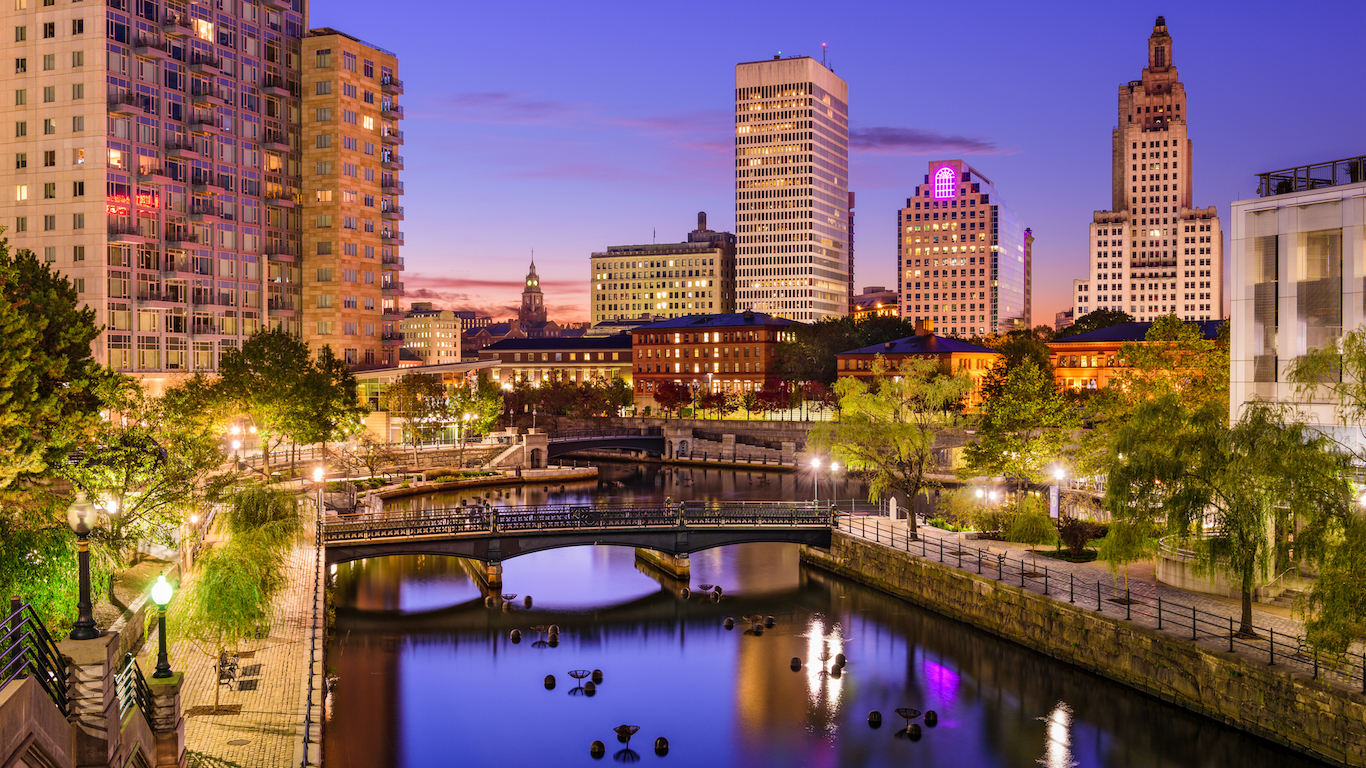
Rhode Island: Providence
> Population: 179,214
> Median home value: $179,400
> Poverty rate: 24.7%
> Violent crimes per 100,000 people: 575
Providence has a relatively low median household income. The typical Providence household earns $40,335 a year, about $20,000 below the median income across the state as a whole. Low income households in the city are strained further by a high cost of living. Goods and services are nearly 20% higher in Providence than they are nationwide, on average.
Providence, like many other low-income areas, has a higher than typical violent crime rate. There were 575 violent crimes reported in the city for every 100,000 residents in 2016. Statewide, there were 239 violent crimes per 100,000 residents that year.
[in-text-ad-2]
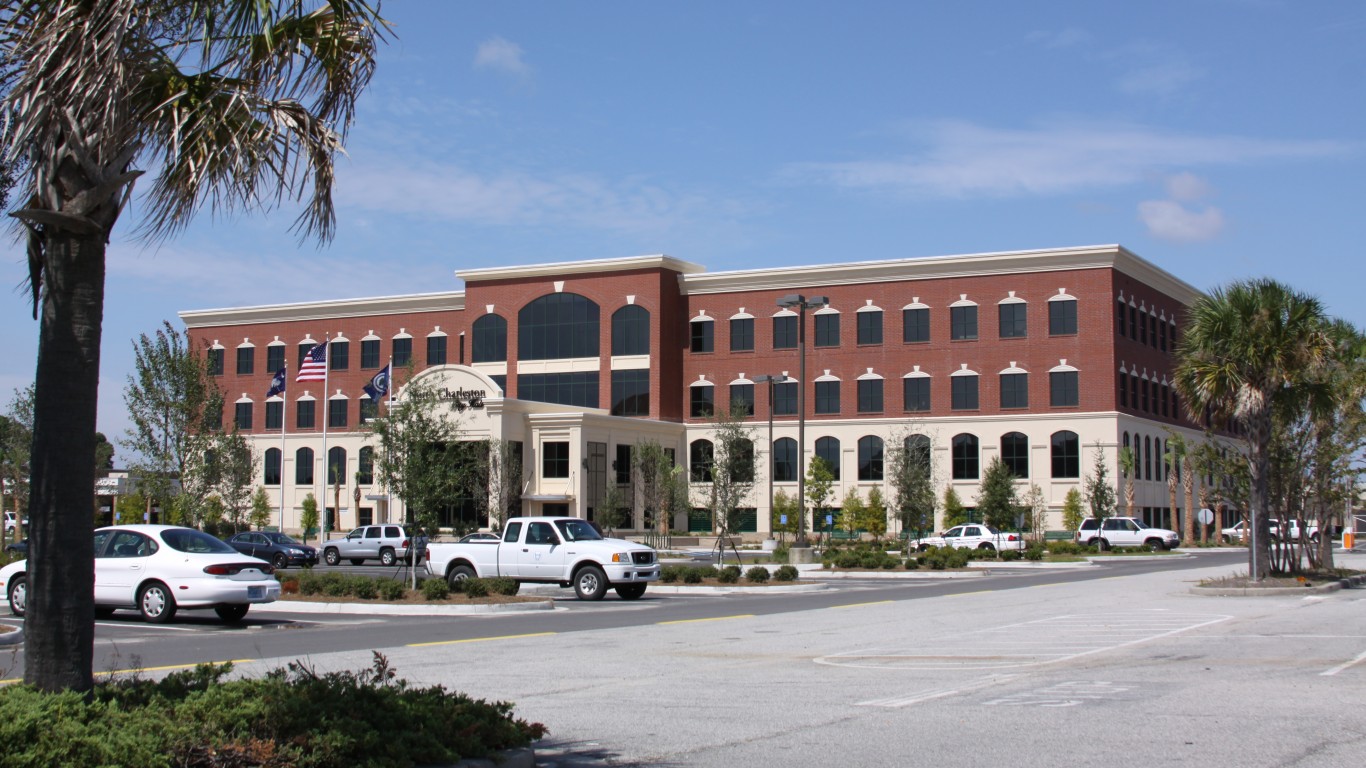
South Carolina: North Charleston
> Population: 112,147
> Median home value: $152,000
> Poverty rate: 25.8%
> Violent crimes per 100,000 people: 885
North Charleston residents face an elevated risk of property damage, injury, and death due to natural disasters. Situated in between the Cooper River and the Ashley River, near their confluence along the Atlantic coast, North Charleston is particularly vulnerable to hurricanes.
North Charleston has many other similar hallmarks to places ranked as the worst cities in their state. Its 25.8% poverty rate is the highest of any city in the state, and the city’s median household income is the lowest in the state, at $35,600 a year.
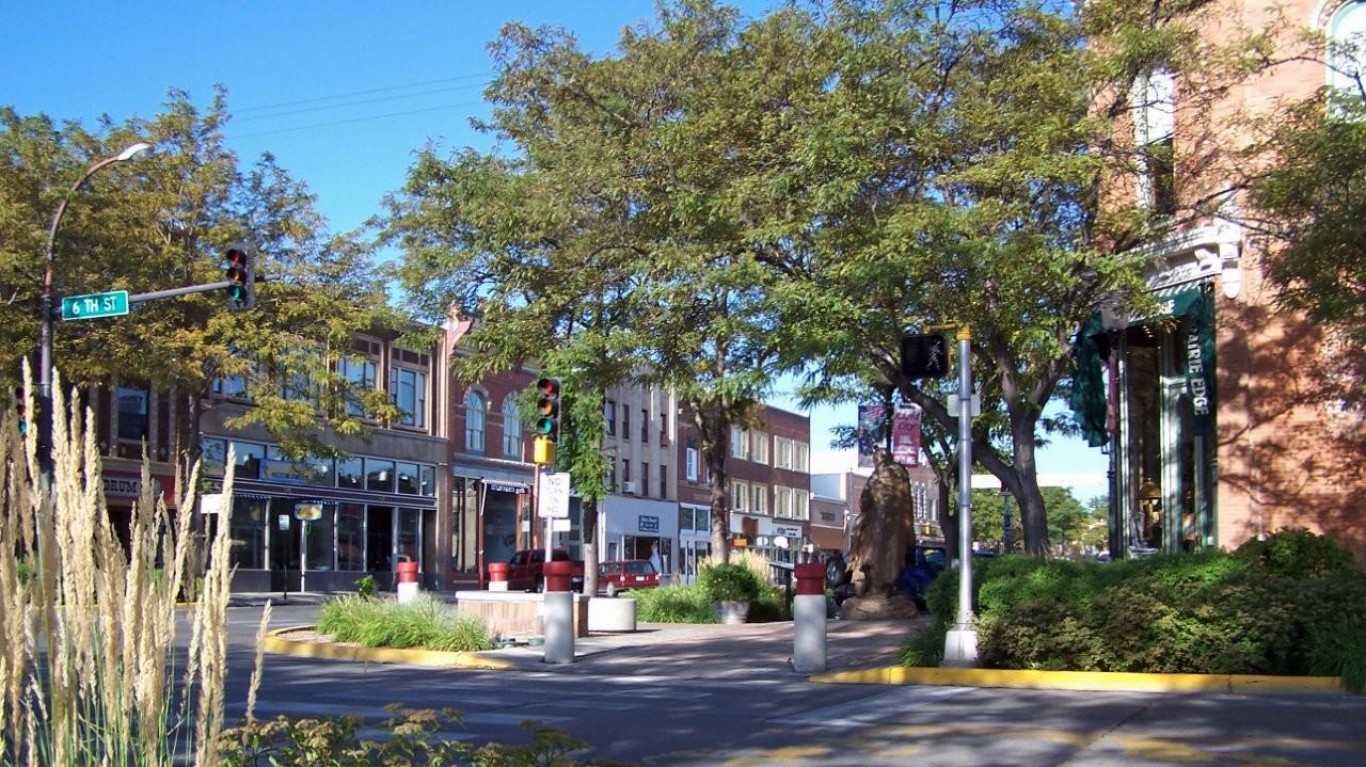
South Dakota: Rapid City
> Population: 74,050
> Median home value: $177,700
> Poverty rate: 18.2%
> Violent crimes per 100,000 people: 724
Rapid City falls slightly behind South Dakota as a whole in a number of key categories indicative of overall quality of life. Rapid City’s unemployment rate of 3.2%, while lower than the comparable 4.9% national rate, is slightly above of South Dakota’s 2.8% unemployment rate.
There is a much larger difference in the poverty rate. Some 18.2% of Rapid City residents live below the poverty line, compared to 13.3% of South Dakotans overall. Rapid City also has a much lower median annual household income than the state as a whole — $47,813 compared to $54,467.
[in-text-ad]

Tennessee: Memphis
> Population: 652,752
> Median home value: $96,800
> Poverty rate: 26.9%
> Violent crimes per 100,000 people: 1,830
Memphis is the most violent place in Tennessee and one of the most violent places in the country. There were 1,830 violent crimes reported for every 100,000 residents in the city in 2016. Across Tennessee as a whole, there were 633 violent crimes per 100,000 people in 2016, one of the higher violent crime rates among states.
As is the case in many other dangerous American cities, serious financial hardship is relatively common in Memphis. Memphis has a poverty rate of 26.9%, the highest in the state and well above Tennessee’s 15.8% poverty rate.
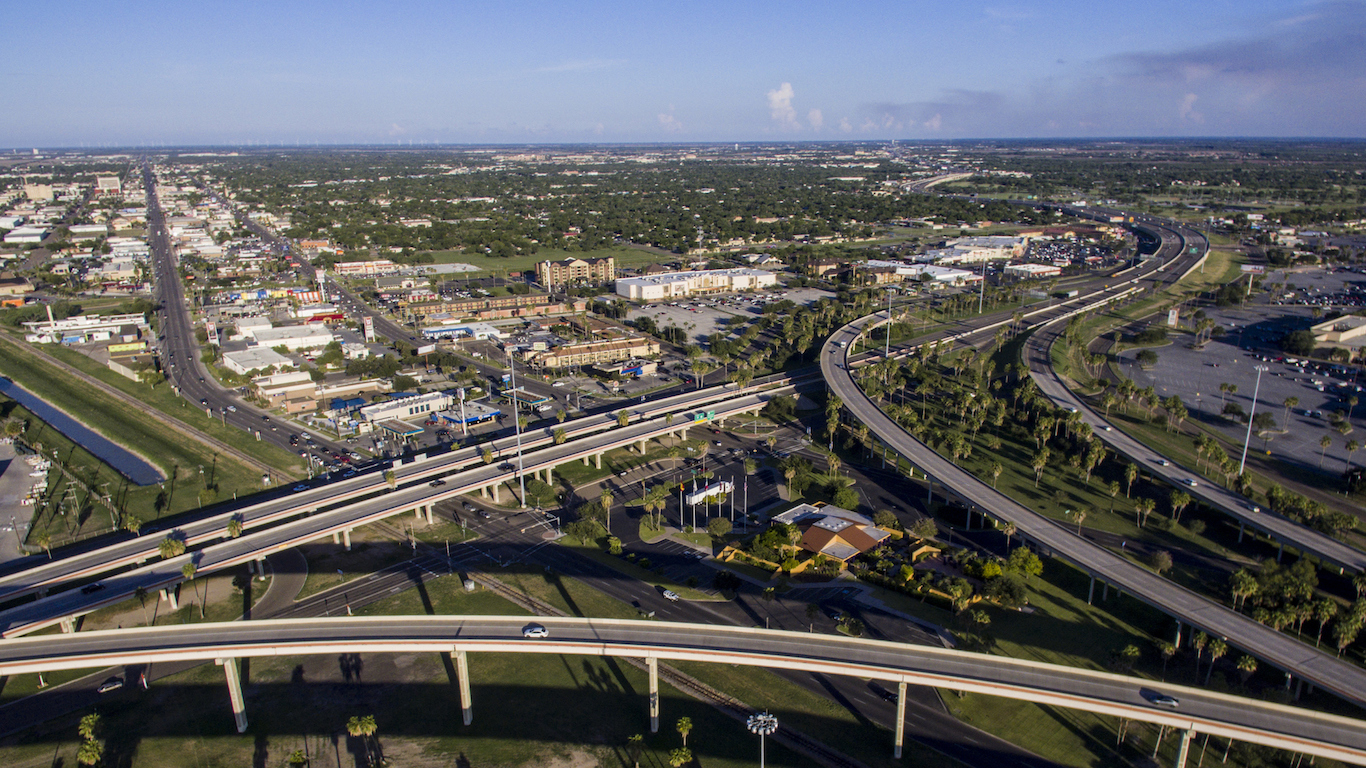
Texas: Harlingen
> Population: 65,533
> Median home value: $89,500
> Poverty rate: 28.3%
> Violent crimes per 100,000 people: 429
Harlingen, a city at the southern tip of Texas, lags behind the Lone Star state in a number of key economic indicators. At 28.3%, Harlingen’s poverty rate is much higher than the 15.6% poverty rate across Texas as whole.
The unemployment rate in Harlingen of 6.1% is well above the state’s 4.6% unemployment rate. Like many cities on this list, Harlingen’s population is shrinking. In the last five years, the number of people living in the city declined by 0.9%, even as the U.S. population as a whole grew by 3.7%.
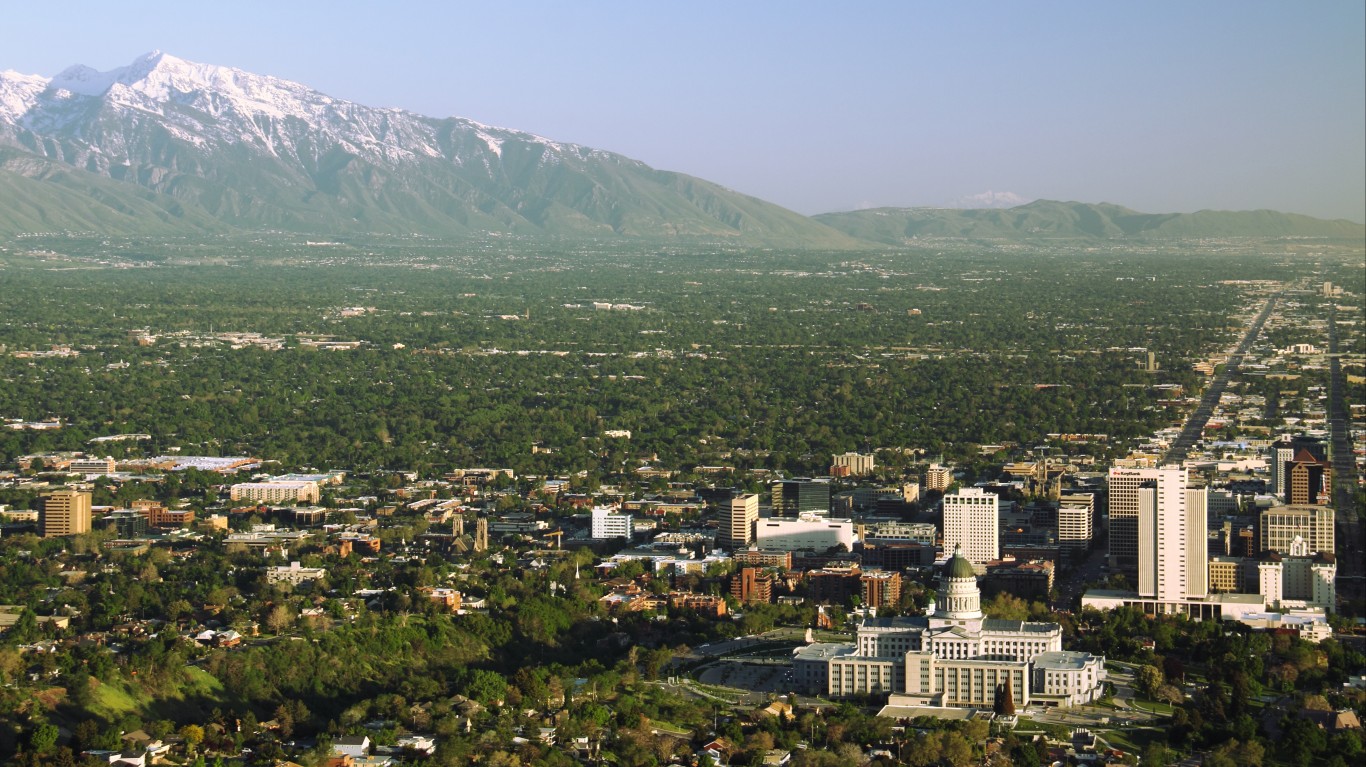
Utah: Salt Lake City
> Population: 193,776
> Median home value: $285,100
> Poverty rate: 16.1%
> Violent crimes per 100,000 people: 937
Salt Lake City has by far the highest violent crime rate in Utah — which is overall one of the safest states in the country. There were 243 violent crimes for every 100,000 Utah residents in 2016. In Salt Lake City, that figure is more than three times as high at 937 incidents per 100,000 residents. The city also has one of the highest property crime rates of any U.S. city at 8,541 property crimes for every 100,000 residents.
While cities with high crime rates also often have low incomes, Salt Lake City is an exception. The city’s median household income of $56,994 closely aligns with the $57,617 national median.
[in-text-ad-2]

Vermont: Rutland
> Population: 15,921
> Median home value: $156,100
> Poverty rate: 16.2%
> Violent crimes per 100,000 people: 50
Rutland residents spend more on essential products and services than the typical American. Goods and services in the city are 8.4% more expensive on average than they are nationwide. Rutland also has the lowest median income of any city in Vermont. The typical area household earns $41,502 a year, $16,175 less than the statewide median.
Aside from a high cost of living, Rutland ranks favorably compared to the country as a whole. For example, the city’s violent crime rate of 50 incidents per 100,000 people is a fraction of the 386 per 100,000 national violent crime rate.
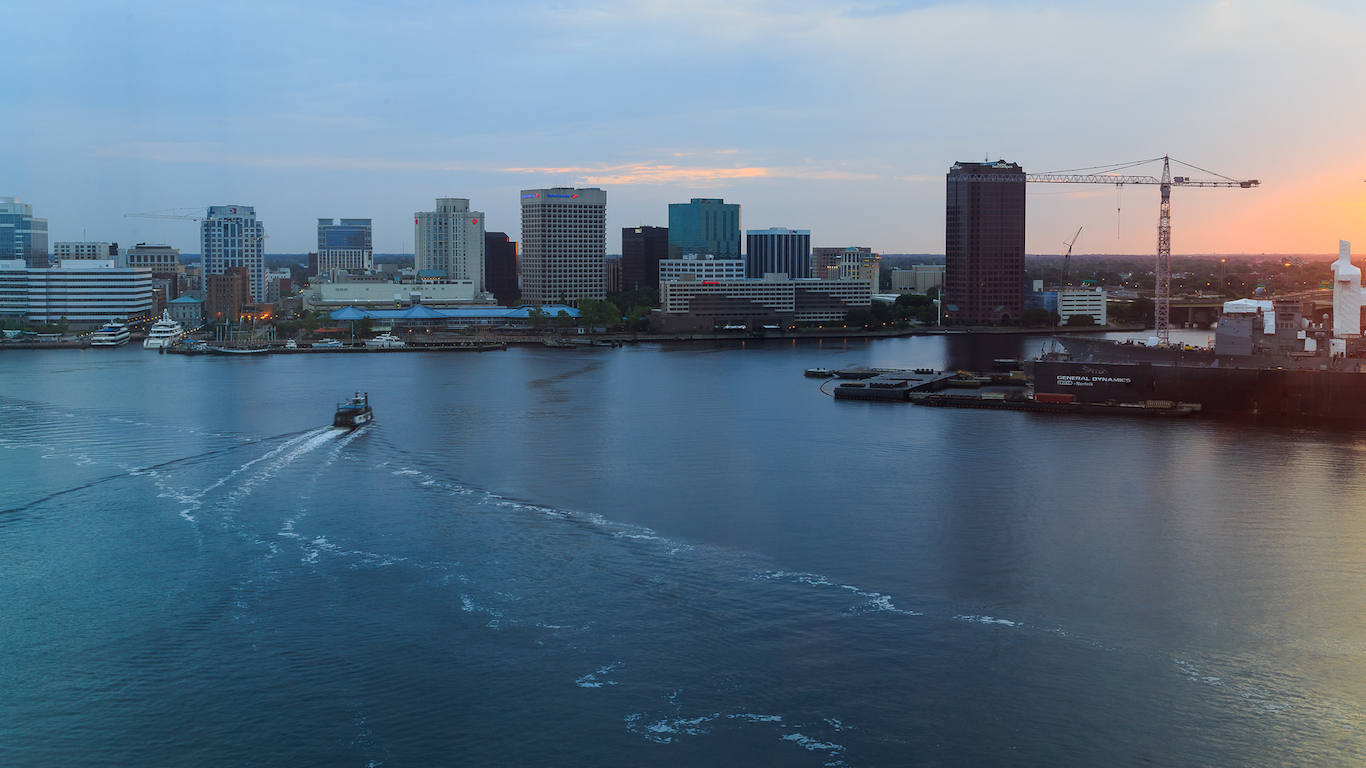
Virginia: Portsmouth
> Population: 95,252
> Median home value: $174,800
> Poverty rate: 17.0%
> Violent crimes per 100,000 people: 796
Portsmouth may be the toughest place in Virginia to get a job. The city’s unemployment rate of 6.1% is the highest in the state. For reference, the statewide unemployment rate is 4.0%. Total employment in the city declined by 0.4% from 2014 to 2016, a time when employment increased by 3.5% across the nation as a whole.
Portsmouth is one of many cities on this list with a shrinking population. In the past decade, the city’s population contracted by 6.6%. Over the same period, the U.S. population expanded by 7.1%.
[in-text-ad]
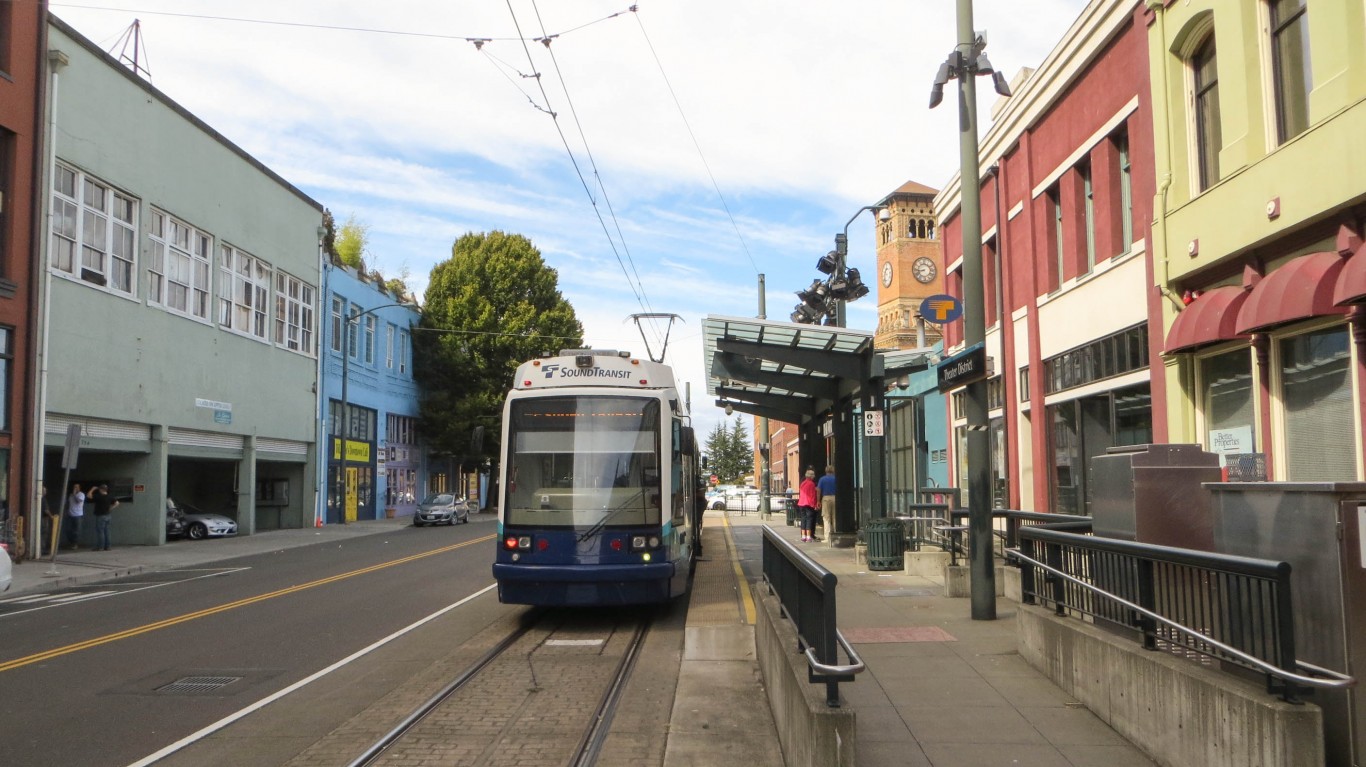
Washington: Tacoma
> Population: 211,304
> Median home value: $239,100
> Poverty rate: 16.3%
> Violent crimes per 100,000 people: 947
The median household income in Tacoma, Washington, is far lower than the statewide median. The typical Tacoma household earns $55,996 a year, while the median income across Washington is $67,106. The lower incomes may be due in part to a weak job market. Tacoma’s annual unemployment rate stands at 6.6%, well above the 5.4% state unemployment rate.
Tacoma is also the most dangerous city in Washington. There were 947 violent crimes for every 100,000 people in the state in 2016, more than triple the 302 per 100,000 violent crime rate across Washington as a whole.
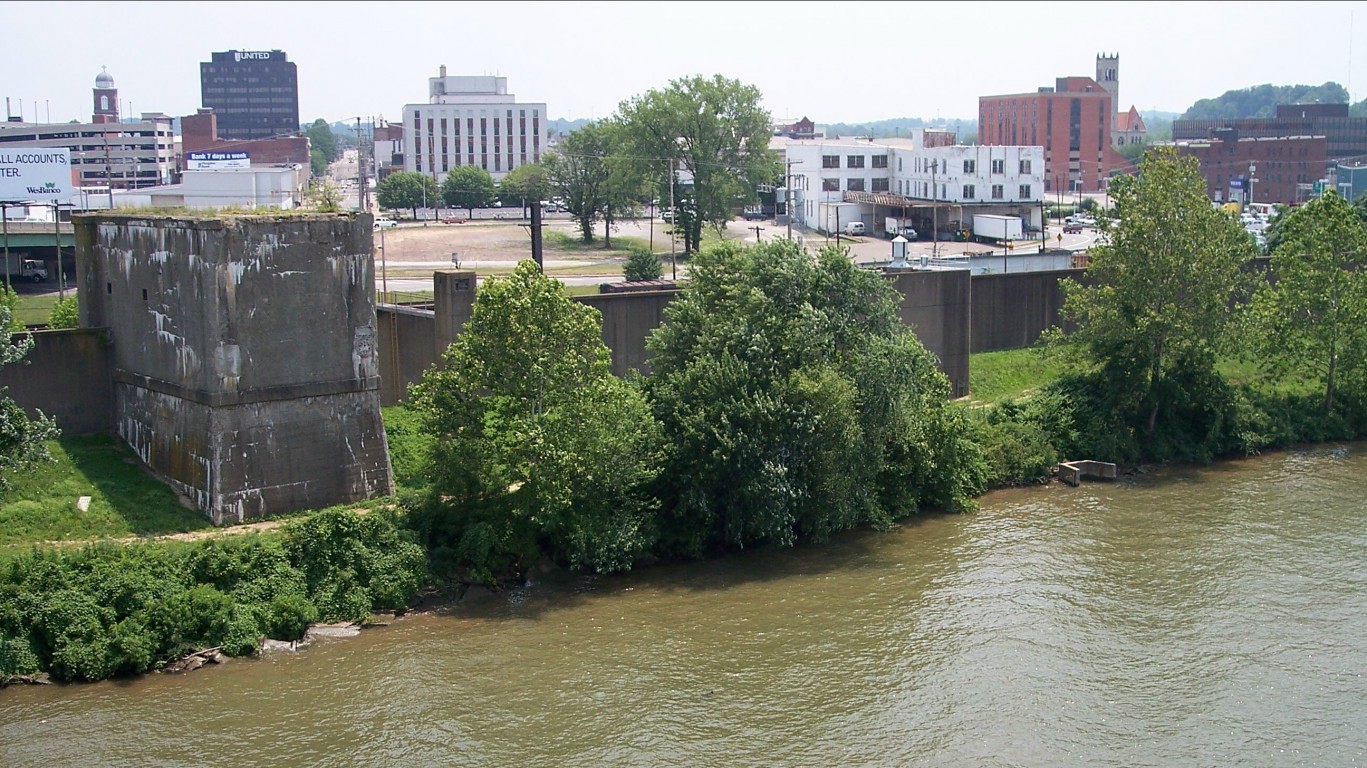
West Virginia: Parkersburg
> Population: 30,962
> Median home value: $86,100
> Poverty rate: 25.3%
> Violent crimes per 100,000 people: 666
Parkersburg, West Virginia, is one of the of the poorest cities in the country. The typical household in the city earns just $34,296 a year, compared to the national median income of $57,617 a year. Additionally, more than one in every four Parkersburg residents live below the poverty line, compared to the 14% national poverty rate.
Poorer populations often report worse health outcomes than more affluent areas — and few places in the country have worse health indicators than Parkersburg. Parkersburg has one of the highest hospital 30-day mortality and readmittance rates in the country. Some 13.4% of people who are hospitalized in the city die within one month of admittance. Also, 16.0% of people who are hospitalized in Parkersburg are readmitted to the hospital with 30 days.

Wisconsin: Milwaukee
> Population: 595,070
> Median home value: $114,700
> Poverty rate: 26.7%
> Violent crimes per 100,000 people: 1,546
Milwaukee has an extremely high violent crime rate, especially when compared to Wisconsin as a whole. There were 1,546 violent crimes reported in the city for every 100,000 residents in 2016 — five times the comparable statewide rate. The next highest violent crime rate in Wisconsin is in Green Bay, where there were 480 incidents per 100,000 residents in 2016. Violence is often more common in low-income areas, and Milwaukee’s median household income of $38,097 a year is well below the state’s median income of $56,811 a year. Milwaukee also has the highest poverty rate of any Wisconsin city at 26.7%.
The city’s crime problem could be driving residents away. Milwaukee is by far Wisconsin’s most populous city, but its population contracted by 0.5% in the past five years.
[in-text-ad-2]
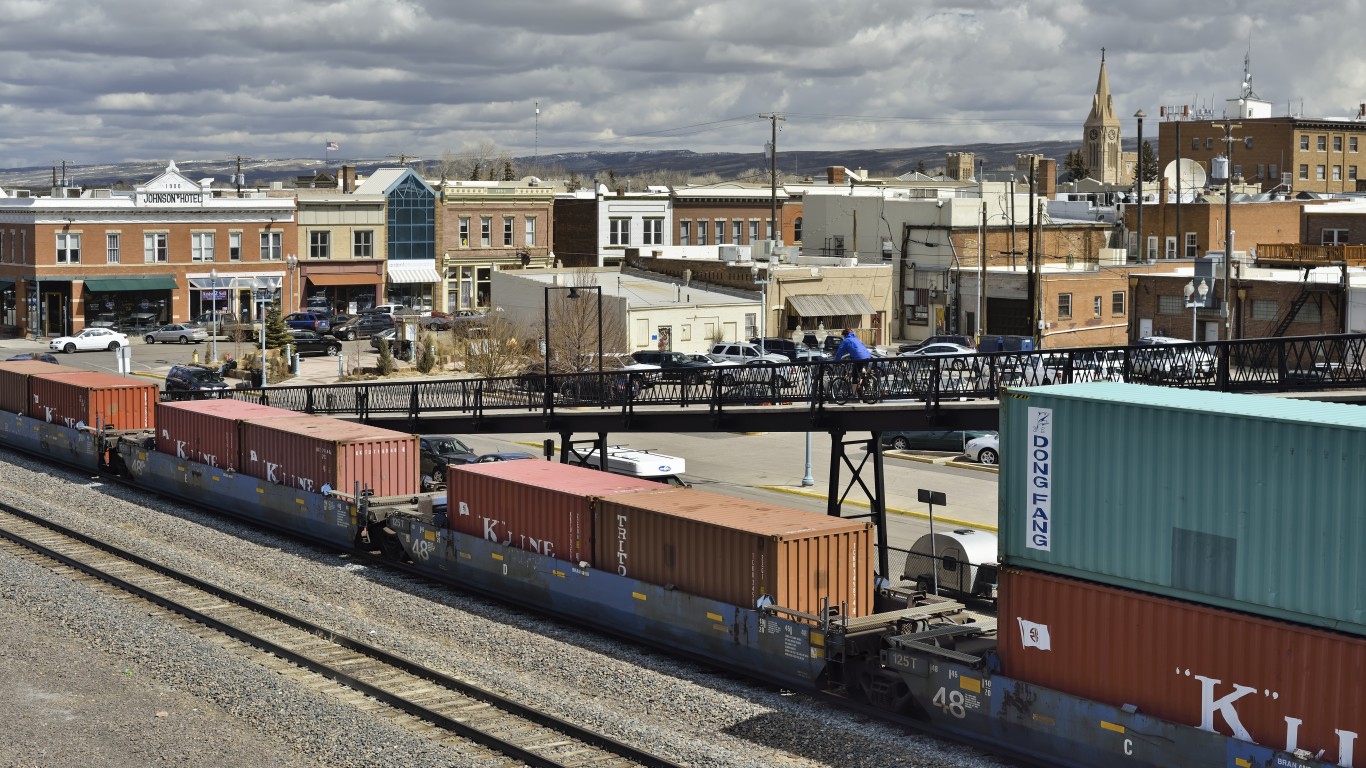
Wyoming: Laramie
> Population: 32,096
> Median home value: $206,700
> Poverty rate: 28.8%
> Violent crimes per 100,000 people: .
Laramie’s median annual household income of $40,240 is by far the lowest of any large city in the state and about $18,900 below the median income across Wyoming as a whole. Financial hardship is also relatively common in Laramie. The city’s poverty rate of 28.8% is more than double the poverty rates in the state’s two other large cities. The poverty rate in Cheyenne is 11.1%, and in Casper it is 10.7%.
Housing costs are high in the city relative to incomes. The typical Laramie home is worth $206,700 — over five times the median income. In Wyoming’s other two cities, median home values are only about three times higher than median incomes, in line with the national housing affordability ratio.
Detailed Findings
Economic and social conditions can vary considerably among the cities on this list, even though they each rank as the worst city in their respective state. In some cases, quality of life is truly poor for many city residents. Detroit is one such example. The quintessential Rust Belt city, Detroit’s violent crime rate of 2,037 incidents per 100,000 people and 10.9% unemployment rate are the highest in the state and nearly the highest in the country.
Not every city on this list is like Detroit, however. Several are on this list not because living conditions there are poor, but because conditions in other cities in the state are even better. For example, in Manchester — ranked as the worst city in New Hampshire — the 3.0% unemployment rate is well below the 4.9% national rate but not quite as low as the 2.8% statewide rate. Similarly, Manchester’s 14.1% poverty rate is almost exactly in line with the national poverty rate but higher than the poverty rates in both of the state’s other comparable cities, Concord and Nashua.
Socioeconomic measures can influence one another in any American city, and one weak economic measure often has ripple effects. For example, a high unemployment rate will often mean more families are financially strapped and poverty is more common. Of the 31 cities on this list with higher unemployment than the national rate, all but two also have a higher poverty rate than the 14.0% national rate.
The presence of violent crime in a city can also have wide reaching effects — making a city less attractive for businesses, dragging down property values, and affecting the mental and overall health of residents. Violent crime rates often are high in the cities on this list. In 42 of the worst cities to live in every state, the violent crime rate exceeds the national rate of 386 incidents per 100,000 people. In 30 of those cities, the violent crime rate is more than double the national rate.
In addition to these interconnected socioeconomic measures, 24/7 Wall St. also considered a range of other measures related to quality of life, including hospital quality, school quality, infrastructure, commute times, the concentration of entertainment and cultural venues, risk of natural disasters, air quality, and housing affordability.
Methodology
To determine the worst city to live in each state, 24/7 Wall St. considered all cities with populations of 65,000 or more residents in 2016. Population data came from U.S. Census Bureau 2016 American Community Survey. When a state had fewer than three cities with a population of at least 65,000, we reduced the population limits by increments of 10,000 until at least three cities could be compared. Data was collected in eight major categories: crime, economy, education, environment, health, housing, infrastructure, and leisure.
Within each category, specific measures contributed to a city’s overall category score. For example, the economy category included poverty and unemployment rates, as well as a city’s three-year employment growth, median household income adjusted for cost of living, and the ratio between a city’s and its state’s median household income.
The crime category consists of both violent and property crime rates from the FBI’s 2016 Uniform Crime Report. Cities with crime rates lower than the national rates were rewarded, while cities with higher crime rates were penalized.
The economy category includes a city’s 2016 unemployment rate and employment growth from 2014-2016, both from the Bureau of Labor Statistics. We also considered the poverty rate in this category. Cities were penalized for having poverty rates above the national rate of 14.0%. Cities were penalized if cost-adjusted incomes were less than $46,093.60 or more than $115,234.00 a year, roughly 80% to 200% of a typical household’s income nationwide. Poverty rates and median income came from the 2016 ACS. Cost of living data came from property and real estate data provider ATTOM Data Solutions.
As a proxy for school system strength, we considered high school standardized test scores relative to state scores from ATTOM Data Solutions. Test score data are for 2016 or the most recently available year. Additionally, the education category includes the percentage of adults with at least a bachelor’s degree from the ACS, as well as the number of colleges and universities in a city per 100,000 residents from the Department of Education. Both measures are as of 2016.
Some metrics in the environment category are for the county in which the city is located because weather is likely similar, if not the same, in these two geographies. This category included an air quality index to assess the levels of a variety of pollutants on a given day. Additionally, we considered an index measuring natural hazard risk, as well as average monthly rainfall. All data in this category came from ATTOM Data Solutions.
In the health category, we examined the rate at which individuals were readmitted to a hospital within 30 days of being discharged. This category also includes preventable hospitalizations — the share of hospitalizations that could have been treated with outpatient or ambulatory care for every 1,000 Medicare recipients from County Health Rankings.
In our housing index, we considered the ratio of a city’s median home value to the statewide median home value. Cities were penalized if a city’s home values were worth less than 90% of statewide home values. Conversely, if home values were typically 25% higher or more than across the state, high barriers to entry exist that can make a city unaffordable. As an additional measure of affordability, we included the ratio of median home value to median annual household income. This ratio — called a price-to-income ratio — helps identify cities that are liveable for a broad population. We also considered median property taxes as a percentage of median home value. All data in this category came from the 2016 ACS.
From the ACS, we considered the percentage of commuters travelling to work by foot or public transportation. Additionally, we reviewed the average time it takes to travel to work each day. Lastly, we included the number of airports in the metro area in which the city is located. There are, for example, no airports in New York County, the primary county of New York City. However, at least three major airports exist outside county limits — and within the metro area — that service people who live in the city. Airport data came from the Federal Aviation Administration and only considers operational public-use and commercial airports as of 2015.
We included in this index the number of restaurants, zoos, nature parks, ski resorts, and golf courses in the counties surrounding the city. All data in this category was aggregated to the city level from 2015 Zip Code Business Patterns, a program maintained by the Census and adjusted for the city’s 2016 population.
Thank you for reading! Have some feedback for us?
Contact the 24/7 Wall St. editorial team.